Paul van Yperen's Blog, page 282
February 2, 2018
Photochemie
The German company Photochemie published only film star postcards of German actors, although there were some postcards for Danish, Norwegian and Hungarian actors who were performing in Germany. The dates of the postcards range from 1914 to 1919. There does not seem to be any cards of the first 100 numbers, nor any cards from #300 until #1300. Photochemie also published cards of other subjects.
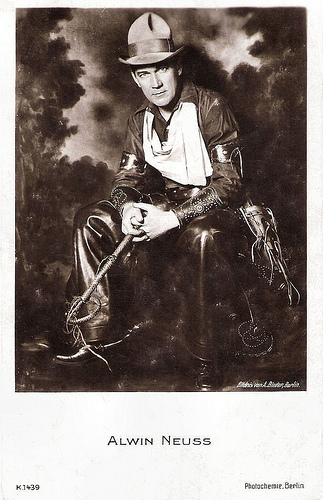
Alwin Neuss . German postcard by Photochemie, Berlin, no. K 1439. Photo: Alex Binder, Berlin.
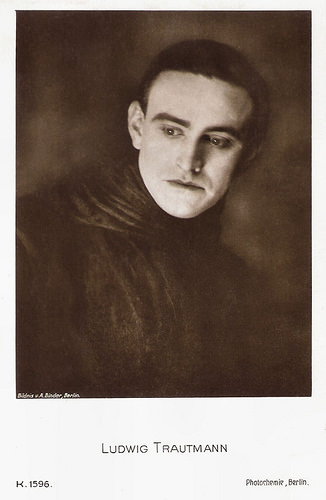
Ludwig Trautmann . German postcard by Photochemie, Berlin, no. K. 1596. Photo: Alex Binder, Berlin.
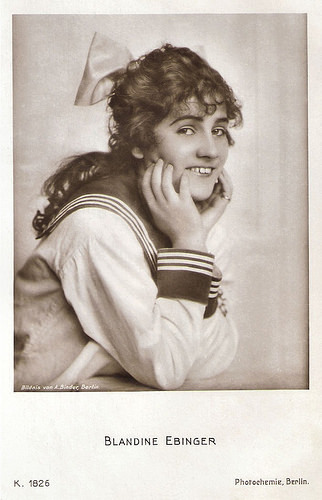
Blandine Ebinger . German postcard by Photochemie, Berlin, no. K. 1826. Photo: Alex Binder, Berlin.
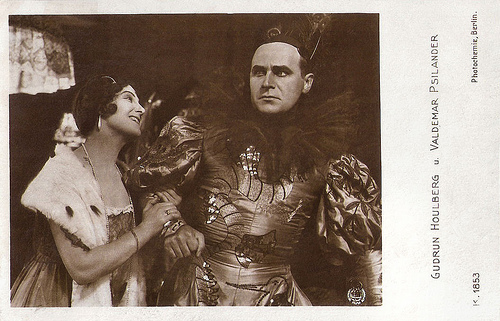
Valdemar Psilander and Gudrun Houlberg. German postcard by Photochemie, Berlin, K. 1853. Photo: Nordisk Films. Publicity still for Klovnen/The Clown (A.W. Sandberg, 1917).
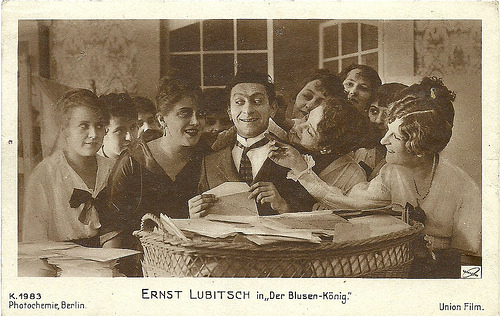
Ernst Lubitsch . German postcard by Photochemie, no. K. 1983. Photo: Union Film. Publicity still for Der Blusen-König (Ernst Lubitsch, 1917). Collection: Didier Hanson.
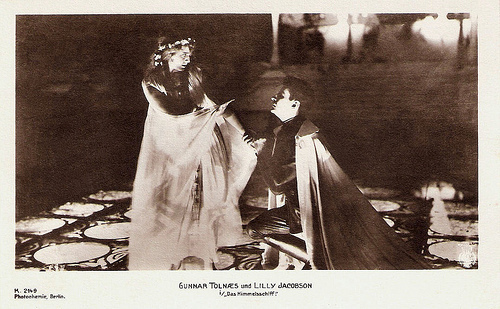
Gunnar Tolnaes and Lilly Jacobson . German postcard by Photochemie, Berlin, no. K. 2149. Photo: Nordisk. Publicity still for Himmelskibet/Das Himmelschiff (Holger-Madsen, 1918).

Lotte Neumann . German postcard by Photochemie, no. K. 2168. Photo: Lotte Neumann-Film, Berlin. Publicity still for Die Ehe der Charlotte von Brakel/The Marriage of Charlotte von Brakel (Paul von Woringen, 1918).

Ossi Oswalda. German postcard by Photochemie, Berlin, no. K. 2186. Photo: Alard Walten, Berlin.
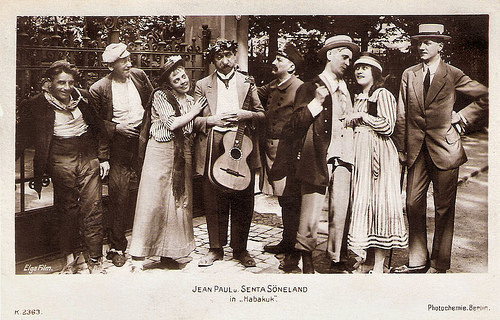
Senta Söneland and Jean Paul. German postcard by Photochemie, Berlin, no. K. 2363. Photo: Elga Film. Publicity still for Habakuk (Franz Schmelter, 1918).
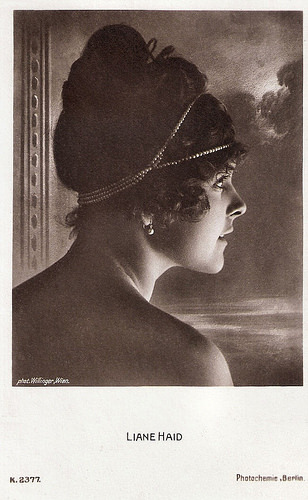
Liane Haid . German postcard by Photochemie, Berlin, no. K. 2377. Photo: Willinger, Wien (Vienna).
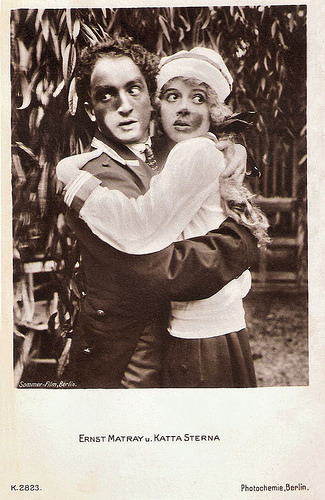
Ernst Matray and Katta Sterna. German postcard by Photochemie, Berlin, no. K. 2823. Photo: Sommer Film, Berlin.
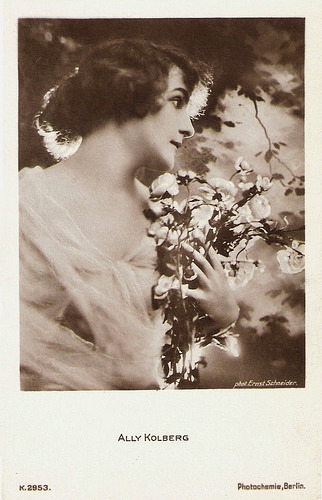
Ally Kolberg . German postcard by Photochemie, Berlin, no. K. 2954. Photo: Ernst Schneider.
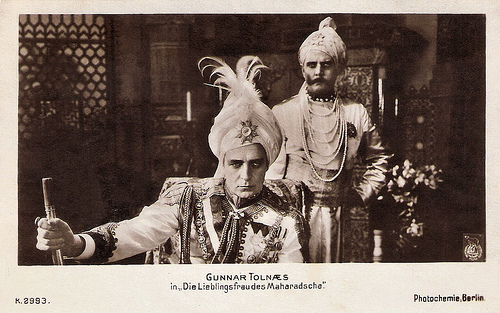
Gunnar Tolnaess . German postcard by Photochemie, no. K. 2993. Photo: Nordisk. Publicity still for Maharadjahens Yndlingshustru/Die Lieblingsfrau des Maharadscha (Robert Dinesen, Svend Gade, 1917).
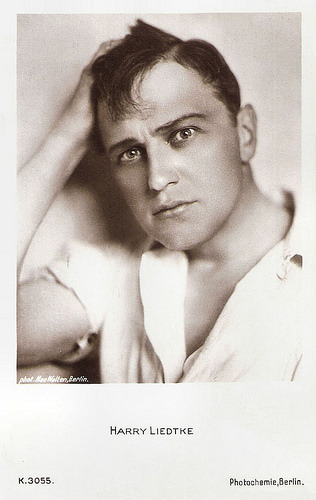
Harry Liedtke . German postcard by Photochemie, Berlin, no. K. 3055. Photo: Mac Walten, Berlin.
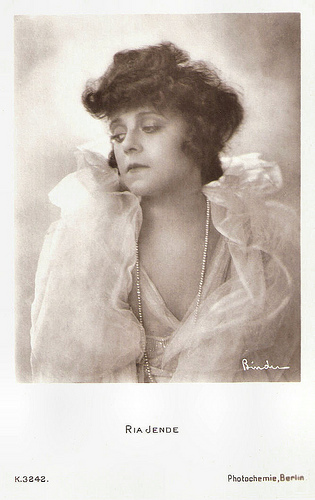
Ria Jende . German postcard by Photochemie, Berlin, no. K. 3842. Photo: Alex Binder.
Source: Mark Goffee (Ross Postcards)

Alwin Neuss . German postcard by Photochemie, Berlin, no. K 1439. Photo: Alex Binder, Berlin.

Ludwig Trautmann . German postcard by Photochemie, Berlin, no. K. 1596. Photo: Alex Binder, Berlin.

Blandine Ebinger . German postcard by Photochemie, Berlin, no. K. 1826. Photo: Alex Binder, Berlin.

Valdemar Psilander and Gudrun Houlberg. German postcard by Photochemie, Berlin, K. 1853. Photo: Nordisk Films. Publicity still for Klovnen/The Clown (A.W. Sandberg, 1917).

Ernst Lubitsch . German postcard by Photochemie, no. K. 1983. Photo: Union Film. Publicity still for Der Blusen-König (Ernst Lubitsch, 1917). Collection: Didier Hanson.

Gunnar Tolnaes and Lilly Jacobson . German postcard by Photochemie, Berlin, no. K. 2149. Photo: Nordisk. Publicity still for Himmelskibet/Das Himmelschiff (Holger-Madsen, 1918).

Lotte Neumann . German postcard by Photochemie, no. K. 2168. Photo: Lotte Neumann-Film, Berlin. Publicity still for Die Ehe der Charlotte von Brakel/The Marriage of Charlotte von Brakel (Paul von Woringen, 1918).

Ossi Oswalda. German postcard by Photochemie, Berlin, no. K. 2186. Photo: Alard Walten, Berlin.

Senta Söneland and Jean Paul. German postcard by Photochemie, Berlin, no. K. 2363. Photo: Elga Film. Publicity still for Habakuk (Franz Schmelter, 1918).

Liane Haid . German postcard by Photochemie, Berlin, no. K. 2377. Photo: Willinger, Wien (Vienna).

Ernst Matray and Katta Sterna. German postcard by Photochemie, Berlin, no. K. 2823. Photo: Sommer Film, Berlin.

Ally Kolberg . German postcard by Photochemie, Berlin, no. K. 2954. Photo: Ernst Schneider.

Gunnar Tolnaess . German postcard by Photochemie, no. K. 2993. Photo: Nordisk. Publicity still for Maharadjahens Yndlingshustru/Die Lieblingsfrau des Maharadscha (Robert Dinesen, Svend Gade, 1917).

Harry Liedtke . German postcard by Photochemie, Berlin, no. K. 3055. Photo: Mac Walten, Berlin.

Ria Jende . German postcard by Photochemie, Berlin, no. K. 3842. Photo: Alex Binder.
Source: Mark Goffee (Ross Postcards)
Published on February 02, 2018 22:00
February 1, 2018
Angelika Meissner (1940-2018)
On 10 January 2018, German former actress Angelika Meissner (1940) passed away. She was a child star of German cinema in the 1950s, who became known with the three popular Immenhof films. Her mother was the stage mum from hell.
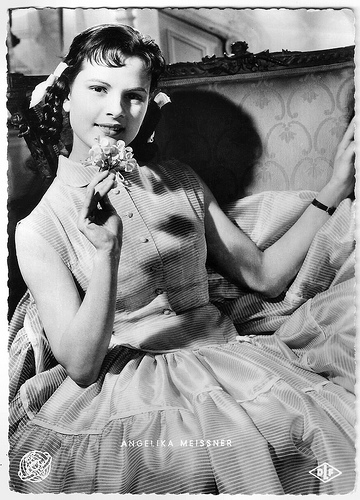
German postcard by Kunst und Bild, Berlin, no. F 10. Photo: A. Grimm / CCC / Deutsche London. Publicity still for Der erste Frühlingstag/The first day of spring (Helmut Weiss, 1956).

German postcard by Rüdel-Verlag, Hamburg-Bergedorf., no. 2080. Photo: Deutsche Film Hansa / Lilo. Publicity still for Witwer mit 5 Töchtern/Widower with 5 Daughters (Erich Engels, 1957).
Cute little girl
Angelika Meissner, a.k.a. Angelika Voelkner and Angelika Meissner-Voelkner, was born in, 1940 in Berlin. Her father was composer Peter Heinz Voelkner. Her mother, Hildegard Voelkner, nee Meissner, was the head of the advertising department at UFA.
In 1949, Angelika played her first film role in the drama Nachtwache/Keepers of the Night (Harald Braun, 1949) as the little daughter of Hans Nielsen.
In her second film Der fallende Stern/The Falling Star (Harald Braun, 1950), she played Elisabeth Hollreiser, traumatised by the post-war turmoil, as a ten-year-old girl. Maria Wimmer played the adult Elisabeth.
In the Dieter Borsche film Vater braucht eine Frau/Father Needs a Wife (Harald Braun, 1952), she played the cute Ulla who searches with her siblings in newspaper advertisements a new wife for her widowed father. Finally, she also finds her in Susanne ( Ruth Leuwerik ).
In these early films, she appeared as Angelika Voelkner. Later, in Die Mädels vom Immenhof/The Girls from Immenhof (1955), she is credited as Angelika Meissner-Voelkner, while in Ferien auf Immenhof/Holiday at Immenhof (1957), she is credited as Angelika Meissner. The name change was a consequence of the divorce of the parents, and Angelika and her brother both adopted the birth name of their mother.
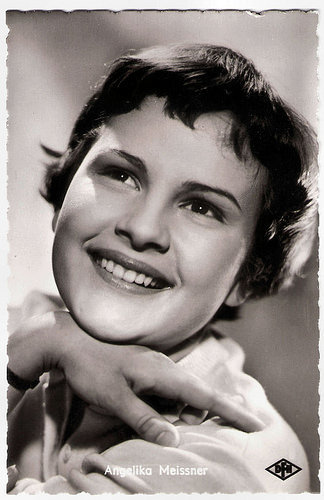
German postcard by Kolibri-Verlag, Minden/Westf., no. 2648. Photo: Deutsche Film Hansa / Lilo. Publicity still for Witwer mit 5 Töchtern/Widower with 5 Daughters (Erich Engels, 1957).
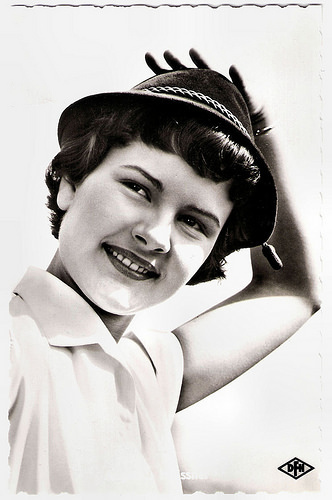
German postcard by Kolibri-Verlag, Minden/Westf., no. 2661. Photo: Deutsche Film Hansa / Lilo. Publicity still for Witwer mit 5 Töchtern/Widower with 5 Daughters (Erich Engels, 1957).
A charming and lively teenager
Angelika Meissner became known in the role of Barbara (nicknamed Dick) in Die Mädels vom Immenhof/The Girls from Immenhof (Wolfgang Schleif, 1955) with Heidi Brühl as her sister Dalli and Margarete Haagen as Grandma Jantzen. The film about a farm with Icelandic horses became a blockbuster.
Meissner also appeared in the sequels, Hochzeit auf Immenhof/Wedding at Immenhof (Volker von Collande, 1956) and Ferien auf Immenhof/Holiday at Immenhof (Hermann Leitner, 1957).
With Matthias Fuchs , Ethelbert in the Immenhof films, she met again, now as a pretty teenager, in the film Der erste Frühlingstag/The first day of spring (Helmut Weiss, 1956).
She was one of the charming and lively daughters of Heinz Erhardt in his film Witwer mit 5 Töchtern/Widower with five daughters (Erich Engels, 1957). The others were played by Susanne Cramer , Vera Tschechowa , Elke Aberle and Christine Kaufmann .
In her last film, the Heimatfilm Hubertusjagd/Hubertus Hunt (Hermann Kugelstadt, 1959), she appeared once more with Raidar Müller, Ralf from the Immenhof-films. Then she abruptly ended her acting career, retired to private life.
Wikipedia cites Micaela Jary, who writes in her book Traumfabriken made in Germany. Die Geschichte des deutschen Nachkriegsfilms 1945–1960 (Dream factories made in Germany. The story of the German post-war film 1945-1960) that Meissner's mother, in anticipation of future salaries, was deeply in debt to her daughter and was ‘film obsessed’.
Angelika Meissner could not withstand the resulting pressure and separated. In 1963, she only played one more role in a German TV film. She studied architecture and moved to Canada, where she occasionally worked as an architect.
Angelika Meissner died on the 10th of January 2018. In German speaking countries, even after sixty years, she was not forgotten and her Immenhof films are still popular among old and new fans.
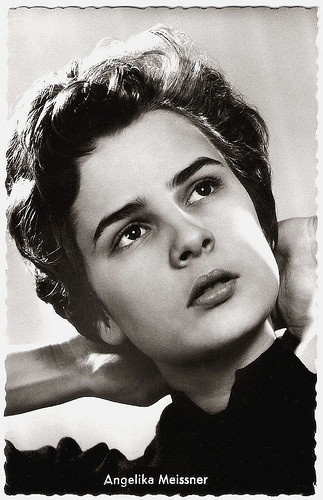
German postcard by Kolibri-Verlag G.m.b.H., Minden/Westf., no. 689. Photo: Kolibri / Lothar Winkler.
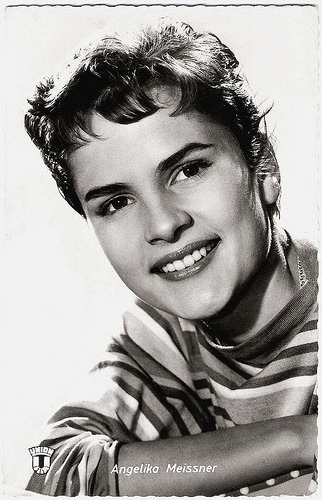
German postcard by Kolibri-Verlag G.m.b.H., Minden/Westf., no. 842. Photo: Carlton / Seitz / Union-Film / Huster. Publicity still for Bei der blonden Kathrein/At the blond Katherine (Hans Quest, 1959).
Sources: Stephanie D’heil (Steffi-Line – German), Wikipedia (German) and .

German postcard by Kunst und Bild, Berlin, no. F 10. Photo: A. Grimm / CCC / Deutsche London. Publicity still for Der erste Frühlingstag/The first day of spring (Helmut Weiss, 1956).

German postcard by Rüdel-Verlag, Hamburg-Bergedorf., no. 2080. Photo: Deutsche Film Hansa / Lilo. Publicity still for Witwer mit 5 Töchtern/Widower with 5 Daughters (Erich Engels, 1957).
Cute little girl
Angelika Meissner, a.k.a. Angelika Voelkner and Angelika Meissner-Voelkner, was born in, 1940 in Berlin. Her father was composer Peter Heinz Voelkner. Her mother, Hildegard Voelkner, nee Meissner, was the head of the advertising department at UFA.
In 1949, Angelika played her first film role in the drama Nachtwache/Keepers of the Night (Harald Braun, 1949) as the little daughter of Hans Nielsen.
In her second film Der fallende Stern/The Falling Star (Harald Braun, 1950), she played Elisabeth Hollreiser, traumatised by the post-war turmoil, as a ten-year-old girl. Maria Wimmer played the adult Elisabeth.
In the Dieter Borsche film Vater braucht eine Frau/Father Needs a Wife (Harald Braun, 1952), she played the cute Ulla who searches with her siblings in newspaper advertisements a new wife for her widowed father. Finally, she also finds her in Susanne ( Ruth Leuwerik ).
In these early films, she appeared as Angelika Voelkner. Later, in Die Mädels vom Immenhof/The Girls from Immenhof (1955), she is credited as Angelika Meissner-Voelkner, while in Ferien auf Immenhof/Holiday at Immenhof (1957), she is credited as Angelika Meissner. The name change was a consequence of the divorce of the parents, and Angelika and her brother both adopted the birth name of their mother.

German postcard by Kolibri-Verlag, Minden/Westf., no. 2648. Photo: Deutsche Film Hansa / Lilo. Publicity still for Witwer mit 5 Töchtern/Widower with 5 Daughters (Erich Engels, 1957).

German postcard by Kolibri-Verlag, Minden/Westf., no. 2661. Photo: Deutsche Film Hansa / Lilo. Publicity still for Witwer mit 5 Töchtern/Widower with 5 Daughters (Erich Engels, 1957).
A charming and lively teenager
Angelika Meissner became known in the role of Barbara (nicknamed Dick) in Die Mädels vom Immenhof/The Girls from Immenhof (Wolfgang Schleif, 1955) with Heidi Brühl as her sister Dalli and Margarete Haagen as Grandma Jantzen. The film about a farm with Icelandic horses became a blockbuster.
Meissner also appeared in the sequels, Hochzeit auf Immenhof/Wedding at Immenhof (Volker von Collande, 1956) and Ferien auf Immenhof/Holiday at Immenhof (Hermann Leitner, 1957).
With Matthias Fuchs , Ethelbert in the Immenhof films, she met again, now as a pretty teenager, in the film Der erste Frühlingstag/The first day of spring (Helmut Weiss, 1956).
She was one of the charming and lively daughters of Heinz Erhardt in his film Witwer mit 5 Töchtern/Widower with five daughters (Erich Engels, 1957). The others were played by Susanne Cramer , Vera Tschechowa , Elke Aberle and Christine Kaufmann .
In her last film, the Heimatfilm Hubertusjagd/Hubertus Hunt (Hermann Kugelstadt, 1959), she appeared once more with Raidar Müller, Ralf from the Immenhof-films. Then she abruptly ended her acting career, retired to private life.
Wikipedia cites Micaela Jary, who writes in her book Traumfabriken made in Germany. Die Geschichte des deutschen Nachkriegsfilms 1945–1960 (Dream factories made in Germany. The story of the German post-war film 1945-1960) that Meissner's mother, in anticipation of future salaries, was deeply in debt to her daughter and was ‘film obsessed’.
Angelika Meissner could not withstand the resulting pressure and separated. In 1963, she only played one more role in a German TV film. She studied architecture and moved to Canada, where she occasionally worked as an architect.
Angelika Meissner died on the 10th of January 2018. In German speaking countries, even after sixty years, she was not forgotten and her Immenhof films are still popular among old and new fans.

German postcard by Kolibri-Verlag G.m.b.H., Minden/Westf., no. 689. Photo: Kolibri / Lothar Winkler.

German postcard by Kolibri-Verlag G.m.b.H., Minden/Westf., no. 842. Photo: Carlton / Seitz / Union-Film / Huster. Publicity still for Bei der blonden Kathrein/At the blond Katherine (Hans Quest, 1959).
Sources: Stephanie D’heil (Steffi-Line – German), Wikipedia (German) and .
Published on February 01, 2018 22:00
Angelika Meissner
German actress Angelika Meissner (1940) was a child star of German cinema in the 1950s. She became known with the three popular Immenhof films. Her mother was the stage mum from hell.

German postcard by Kunst und Bild, Berlin, no. F 10. Photo: A. Grimm / CCC / Deutsche London. Publicity still for Der erste Frühlingstag/The first day of spring (Helmut Weiss, 1956).

German postcard by Rüdel-Verlag, Hamburg-Bergedorf., no. 2080. Photo: Deutsche Film Hansa / Lilo. Publicity still for Witwer mit 5 Töchtern/Widower with 5 Daughters (Erich Engels, 1957).
Cute little girl
Angelika Meissner, a.k.a. Angelika Voelkner and Angelika Meissner-Voelkner, was born in, 1940 in Berlin. Her father was composer Peter Heinz Voelkner. Her mother, Hildegard Voelkner, nee Meissner, was the head of the advertising department at UFA.
In 1949, Angelika played her first film role in the drama Nachtwache/Keepers of the Night (Harald Braun, 1949) as the little daughter of Hans Nielsen.
In her second film Der fallende Stern/The Falling Star (Harald Braun, 1950), she played Elisabeth Hollreiser, traumatised by the post-war turmoil, as a ten-year-old girl. Maria Wimmer played the adult Elisabeth.
In the Dieter Borsche film Vater braucht eine Frau/Father Needs a Wife (Harald Braun, 1952), she played the cute Ulla who searches with her siblings in newspaper advertisements a new wife for her widowed father. Finally, she also finds her in Susanne ( Ruth Leuwerik ).
In these early films, she appeared as Angelika Voelkner. Later, in Die Mädels vom Immenhof/The Girls from Immenhof (1955), she is credited as Angelika Meissner-Voelkner, while in Ferien auf Immenhof/Holiday at Immenhof (1957), she is credited as Angelika Meissner. The name change was a consequence of the divorce of the parents, and Angelika and her brother both adopted the birth name of their mother.

German postcard by Kolibri-Verlag, Minden/Westf., no. 2648. Photo: Deutsche Film Hansa / Lilo. Publicity still for Witwer mit 5 Töchtern/Widower with 5 Daughters (Erich Engels, 1957).

German postcard by Kolibri-Verlag, Minden/Westf., no. 2661. Photo: Deutsche Film Hansa / Lilo. Publicity still for Witwer mit 5 Töchtern/Widower with 5 Daughters (Erich Engels, 1957).
A charming and lively teenager
Angelika Meissner became known in the role of Barbara (nicknamed Dick) in Die Mädels vom Immenhof/The Girls from Immenhof (Wolfgang Schleif, 1955) with Heidi Brühl as her sister Dalli and Margarete Haagen as Grandma Jantzen. The film about a farm with Icelandic horses became a blockbuster.
Meissner also appeared in the sequels, Hochzeit auf Immenhof/Wedding at Immenhof (Volker von Collande, 1956) and Ferien auf Immenhof/Holiday at Immenhof (Hermann Leitner, 1957).
With Matthias Fuchs , Ethelbert in the Immenhof films, she met again, now as a pretty teenager, in the film Der erste Frühlingstag/The first day of spring (Helmut Weiss, 1956).
She was one of the charming and lively daughters of Heinz Erhardt in his film Witwer mit 5 Töchtern/Widower with five daughters (Erich Engels, 1957). The others were played by Susanne Cramer , Vera Tschechowa , Elke Aberle and Christine Kaufmann .
In her last film, the Heimatfilm Hubertusjagd/Hubertus Hunt (Hermann Kugelstadt, 1959), she appeared once more with Raidar Müller, Ralf from the Immenhof-films. Then she abruptly ended her acting career, retired to private life.
Wikipedia cites Micaela Jary, who writes in her book Traumfabriken made in Germany. Die Geschichte des deutschen Nachkriegsfilms 1945–1960 (Dream factories made in Germany. The story of the German post-war film 1945-1960) that Meissner's mother, in anticipation of future salaries, was deeply in debt to her daughter and was ‘film obsessed’.
Angelika Meissner could not withstand the resulting pressure and separated. In 1963, she only played one more role in a German TV film. She studied architecture and moved to Canada, where she occasionally worked as an architect.
In German speaking countries, even after sixty years, Angelika Meissner is not forgotten and her Immenhof films are still popular among old and new fans.

German postcard by Kolibri-Verlag G.m.b.H., Minden/Westf., no. 689. Photo: Kolibri / Lothar Winkler.

German postcard by Kolibri-Verlag G.m.b.H., Minden/Westf., no. 842. Photo: Carlton / Seitz / Union-Film / Huster. Publicity still for Bei der blonden Kathrein/At the blond Katherine (Hans Quest, 1959).
Sources: Stephanie D’heil (Steffi-Line – German), Wikipedia (German) and .

German postcard by Kunst und Bild, Berlin, no. F 10. Photo: A. Grimm / CCC / Deutsche London. Publicity still for Der erste Frühlingstag/The first day of spring (Helmut Weiss, 1956).

German postcard by Rüdel-Verlag, Hamburg-Bergedorf., no. 2080. Photo: Deutsche Film Hansa / Lilo. Publicity still for Witwer mit 5 Töchtern/Widower with 5 Daughters (Erich Engels, 1957).
Cute little girl
Angelika Meissner, a.k.a. Angelika Voelkner and Angelika Meissner-Voelkner, was born in, 1940 in Berlin. Her father was composer Peter Heinz Voelkner. Her mother, Hildegard Voelkner, nee Meissner, was the head of the advertising department at UFA.
In 1949, Angelika played her first film role in the drama Nachtwache/Keepers of the Night (Harald Braun, 1949) as the little daughter of Hans Nielsen.
In her second film Der fallende Stern/The Falling Star (Harald Braun, 1950), she played Elisabeth Hollreiser, traumatised by the post-war turmoil, as a ten-year-old girl. Maria Wimmer played the adult Elisabeth.
In the Dieter Borsche film Vater braucht eine Frau/Father Needs a Wife (Harald Braun, 1952), she played the cute Ulla who searches with her siblings in newspaper advertisements a new wife for her widowed father. Finally, she also finds her in Susanne ( Ruth Leuwerik ).
In these early films, she appeared as Angelika Voelkner. Later, in Die Mädels vom Immenhof/The Girls from Immenhof (1955), she is credited as Angelika Meissner-Voelkner, while in Ferien auf Immenhof/Holiday at Immenhof (1957), she is credited as Angelika Meissner. The name change was a consequence of the divorce of the parents, and Angelika and her brother both adopted the birth name of their mother.

German postcard by Kolibri-Verlag, Minden/Westf., no. 2648. Photo: Deutsche Film Hansa / Lilo. Publicity still for Witwer mit 5 Töchtern/Widower with 5 Daughters (Erich Engels, 1957).

German postcard by Kolibri-Verlag, Minden/Westf., no. 2661. Photo: Deutsche Film Hansa / Lilo. Publicity still for Witwer mit 5 Töchtern/Widower with 5 Daughters (Erich Engels, 1957).
A charming and lively teenager
Angelika Meissner became known in the role of Barbara (nicknamed Dick) in Die Mädels vom Immenhof/The Girls from Immenhof (Wolfgang Schleif, 1955) with Heidi Brühl as her sister Dalli and Margarete Haagen as Grandma Jantzen. The film about a farm with Icelandic horses became a blockbuster.
Meissner also appeared in the sequels, Hochzeit auf Immenhof/Wedding at Immenhof (Volker von Collande, 1956) and Ferien auf Immenhof/Holiday at Immenhof (Hermann Leitner, 1957).
With Matthias Fuchs , Ethelbert in the Immenhof films, she met again, now as a pretty teenager, in the film Der erste Frühlingstag/The first day of spring (Helmut Weiss, 1956).
She was one of the charming and lively daughters of Heinz Erhardt in his film Witwer mit 5 Töchtern/Widower with five daughters (Erich Engels, 1957). The others were played by Susanne Cramer , Vera Tschechowa , Elke Aberle and Christine Kaufmann .
In her last film, the Heimatfilm Hubertusjagd/Hubertus Hunt (Hermann Kugelstadt, 1959), she appeared once more with Raidar Müller, Ralf from the Immenhof-films. Then she abruptly ended her acting career, retired to private life.
Wikipedia cites Micaela Jary, who writes in her book Traumfabriken made in Germany. Die Geschichte des deutschen Nachkriegsfilms 1945–1960 (Dream factories made in Germany. The story of the German post-war film 1945-1960) that Meissner's mother, in anticipation of future salaries, was deeply in debt to her daughter and was ‘film obsessed’.
Angelika Meissner could not withstand the resulting pressure and separated. In 1963, she only played one more role in a German TV film. She studied architecture and moved to Canada, where she occasionally worked as an architect.
In German speaking countries, even after sixty years, Angelika Meissner is not forgotten and her Immenhof films are still popular among old and new fans.

German postcard by Kolibri-Verlag G.m.b.H., Minden/Westf., no. 689. Photo: Kolibri / Lothar Winkler.

German postcard by Kolibri-Verlag G.m.b.H., Minden/Westf., no. 842. Photo: Carlton / Seitz / Union-Film / Huster. Publicity still for Bei der blonden Kathrein/At the blond Katherine (Hans Quest, 1959).
Sources: Stephanie D’heil (Steffi-Line – German), Wikipedia (German) and .
Published on February 01, 2018 22:00
January 31, 2018
Praesten fra havet (1918)
Olaf Fønss was one of Denmark and Germany's biggest stars of the silent film era. He played the leading role in the Dansk Film production Praesten fra havet (Fritz Magnussen, 1918), released in Germany as Der Pfarrer am Meere (The Priest at the Sea). German publishing house Verlag Hermann Leiser produced this sepia tinted series with scenes from the film for the German release of the film.
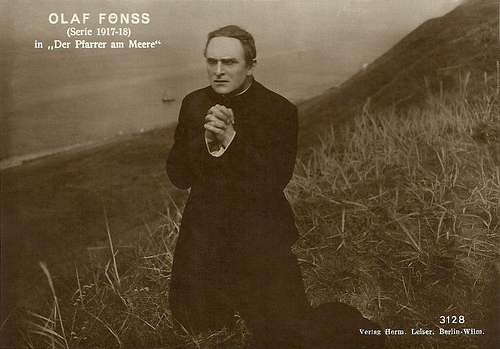
German postcard by Verlag Hermann Leiser, Berlin, no. 3128. Photo: Olaf Fønss in Praesten fra havet (Fritz Magnussen 1918), released in Germany as Der Pfarrer am Meere (The Priest at the Sea).
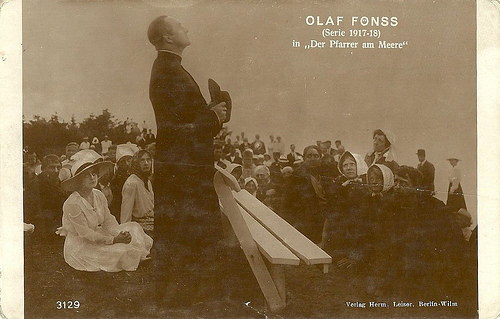
German postcard by Verlag Hermann Leiser, Berlin, no. 3129. Photo: Olaf Fønss in Praesten fra havet/The Priest at the Sea (Fritz Magnussen 1918).
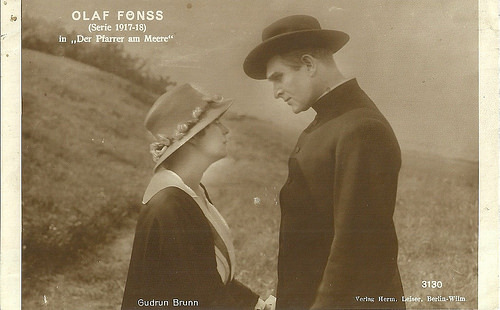
German postcard by Verlag Hermann Leiser, Berlin, no. 3130. Photo: Gudrun Bruun and Olaf Fønss in Praesten fra havet/The Priest at the Sea (Fritz Magnussen 1918).
A vicar caught in a battle
In Praesten fra havet, Olaf Fønss plays vicar Strom. He is caught in a battle between the poor fishermen of the coastal village and the merchant Warming (Cajus Bruun), who owns all the fishing boats.
Warming's daughter, Agnete (Gudrun Bruun a.k.a. Gudrun Brunn and Gudrun Bruun Stephensen), is in love with the young vicar and tries to help him to lessen her father's demands on the fishermen.
Warming's demands of having the fishermen fish day and night is refused, and the merchant calls a lock-out, with poverty and starvation as a result. One day Warming is caught in a storm and the fishermen refuse to assist. They say: "He himself forbade us to use the boats!"
However, when vicar Strom himself enters the boat single-handedly, they are convinced to turn the other cheek and try to save Warming from certain death.
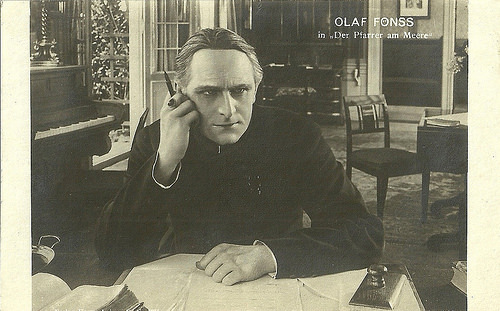
German postcard by Verlag Hermann Leiser, Berlin, no. ?. Photo: Olaf Fønss in Praesten fra havet/The Priest at the Sea (Fritz Magnussen 1918).
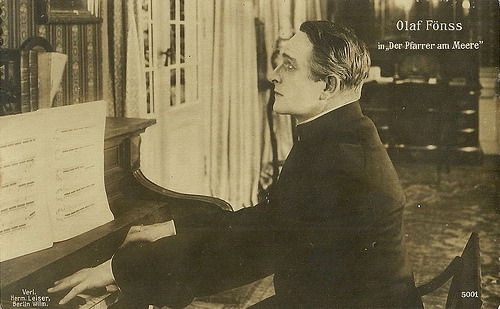
German postcard by Verlag Hermann Leiser, Berlin, no. 5001. Photo: Olaf Fønss in Praesten fra havet/The Priest at the Sea (Fritz Magnussen 1918).
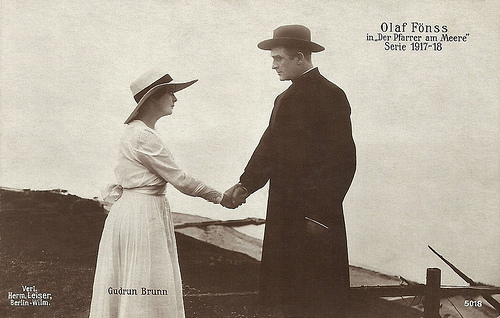
German postcard by Verlag Hermann Leiser, Berlin, no. 5018. Photo: Gudrun Bruun and Olaf Fønss in Praesten fra havet/The Priest at the Sea (Fritz Magnussen 1918).
Sources: Danish Film Institute and IMDb.

German postcard by Verlag Hermann Leiser, Berlin, no. 3128. Photo: Olaf Fønss in Praesten fra havet (Fritz Magnussen 1918), released in Germany as Der Pfarrer am Meere (The Priest at the Sea).

German postcard by Verlag Hermann Leiser, Berlin, no. 3129. Photo: Olaf Fønss in Praesten fra havet/The Priest at the Sea (Fritz Magnussen 1918).

German postcard by Verlag Hermann Leiser, Berlin, no. 3130. Photo: Gudrun Bruun and Olaf Fønss in Praesten fra havet/The Priest at the Sea (Fritz Magnussen 1918).
A vicar caught in a battle
In Praesten fra havet, Olaf Fønss plays vicar Strom. He is caught in a battle between the poor fishermen of the coastal village and the merchant Warming (Cajus Bruun), who owns all the fishing boats.
Warming's daughter, Agnete (Gudrun Bruun a.k.a. Gudrun Brunn and Gudrun Bruun Stephensen), is in love with the young vicar and tries to help him to lessen her father's demands on the fishermen.
Warming's demands of having the fishermen fish day and night is refused, and the merchant calls a lock-out, with poverty and starvation as a result. One day Warming is caught in a storm and the fishermen refuse to assist. They say: "He himself forbade us to use the boats!"
However, when vicar Strom himself enters the boat single-handedly, they are convinced to turn the other cheek and try to save Warming from certain death.

German postcard by Verlag Hermann Leiser, Berlin, no. ?. Photo: Olaf Fønss in Praesten fra havet/The Priest at the Sea (Fritz Magnussen 1918).

German postcard by Verlag Hermann Leiser, Berlin, no. 5001. Photo: Olaf Fønss in Praesten fra havet/The Priest at the Sea (Fritz Magnussen 1918).

German postcard by Verlag Hermann Leiser, Berlin, no. 5018. Photo: Gudrun Bruun and Olaf Fønss in Praesten fra havet/The Priest at the Sea (Fritz Magnussen 1918).
Sources: Danish Film Institute and IMDb.
Published on January 31, 2018 22:00
January 30, 2018
Jan Spitzer
East-German actor Jan Spitzer (1947) was a star of the DEFA in the late 1960s. He also worked as a pop singer and as a stage and voice actor.
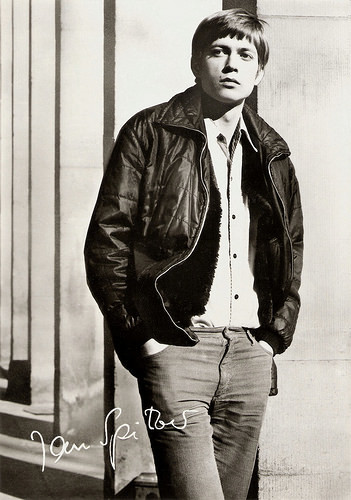
Big East-German card by VEB Progress Film-Vertrieb, Berlin, no. 192/70. Photo: Karin Blasig.
A farewell to his class and his family
Jan Spitzer was born in 1947 in Sangerhausen, Germany. He loved pop music and formed in 1963 of the amateur band The Sounds, which covered songs by The Beatles and The Rolling Stones .
Between 1965 and 1968 he studied acting at the Hochschule für Schauspielkunst ‘Ernst Busch’ in Berlin. As a student, he made his film debut in the anti-war film Abschied/Farewell (Egon Günther, 1968) with Rolf Ludwig. Spitzer played the leading role of a seventeen year-old Munich boy, who decides in 1914 that he will not take part in the First World War. This means a farewell to his class and his family.
He then appeared in the historical comedy Jungfer, Sie gefällt mir/Maiden, I like you (Günter Reisch, 1969) with Wolfgang Kieling and Monika Gabriel.
In 1970 he released the pop single, Wer bist du? (Who are you?) and in the next years he recorded more songs. He did not like the Schlager genre, so in 1975 he decided to focus on his acting career.
His first bigger role was in the family film Philipp, der Kleine/Little Philipp (Herrmann Zschoche, 1978) as the father of a little boy who wishes to be taller in order to be noticed by the others. Then he comes across a magical flute.
In the meanwhile, Spitzer worked for television and could be seen in several TV series and TV movies like Im Schlaraffenland/In the land of Cockaigne (Kurt Jung-Alsen, 1975) with Erwin Geschonneck and Katharina Thalbach , which was shown in cinema in other East-European countries. He also appeared in the Eastern Blauvogel/Bluebird (Ulrich Weiß, 1979). And he played Friedrich Engels in the TV series Marx und Engels - Stationen ihres Lebens/Marx and Engels – Stations of their lives (1978-1980) with Jürgen Reuter as Karl Marx.
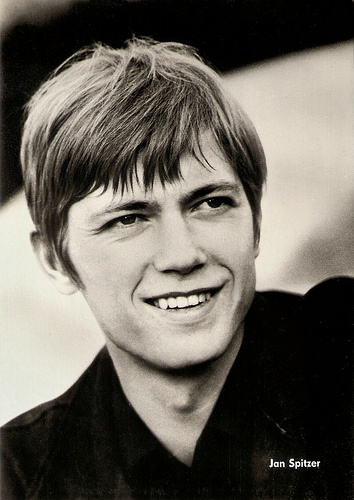
East-German postcard by VEB Progress Film-Vertrieb, Berlin, no. 3246, 1968. Photo: DEFA / Ebert. Publicity still for Abschied/Farewell (Egon Günther, 1968).
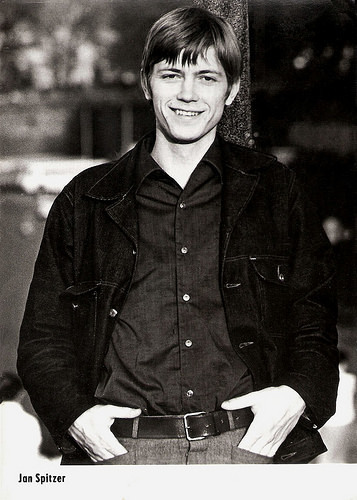
East-German postcard by VEB Progress Film-Vertrieb, Berlin, no. 3270, 1968. Photo: DEFA / Ebert. Publicity still for Abschied/Farewell (Egon Günther, 1968).
The German voice of Rutger Hauer
Jan Spitzer played a supporting part in the film Bürgschaft für ein Jahr/Guarantee for one year (Herrmann Zschoche, 1981) with Kathrin Sass as a divorced woman in her late twenties who will soon be fully deprived of her custody rights for her three children, who already reside in a home for the displaced, due to many years of willful neglect. Sass won the Silver Bear for her role at the Berlin Filmfestival.
Spitzer played a leading role in the Soviet-East-German co-production Dve strochki melkim shriftom/Two Lines in Small Font (Vitaliy Melnikov, 1981). He also appeared in the Czech fantasy film Carovné dedictví/Magical heritage (Zdenek Zelenka, 1986) and in the Eastern Präriejäger in Mexiko: Benito Juarez/Bounty hunter in Mexico: Benito Juarez (Hans Knötzsch, 1988) starring Gojko Mitic .
On TV, he guest-starred in the popular Krimi series Polizeiruf 110/Police Call 110 (1984-1991). After the Wende, Spitzer mostly worked for television but also narrated video games and was the German voice of James Remar, Chris Cooper, Jon Voight, Rutger Hauer and Alan Arkin in international films.
His most recent feature film is the drama Mutterseelenallein/All Alone (Bernd Böhlich, 2005) about a mother (Katrin Sass) who is confronted with her son being suspected of having murdered a girl on a garbage dump. Spitzer played her ex-husband.
Jan Spitzer is also a stage actor and he had engagements in Altenburg, Halle, Schwerin, at the Deutschen Theater in Berlin, at the Volkstheater in Munich and the Berliner Ensemble.
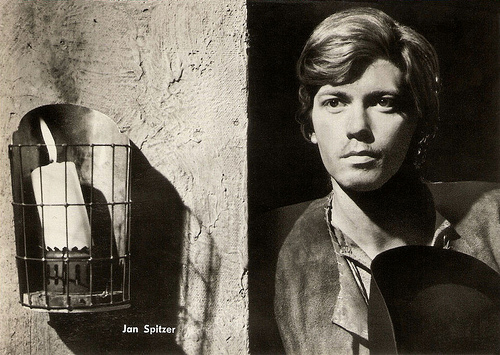
East-German postcard by VEB Progress Film-Vertrieb, Berlin, no. 51/69. Photo: DEFA / Kreuss. Publicity still for Jungfer, Sie gefällt mir/Maiden, I like you (Günter Reisch, 1969).
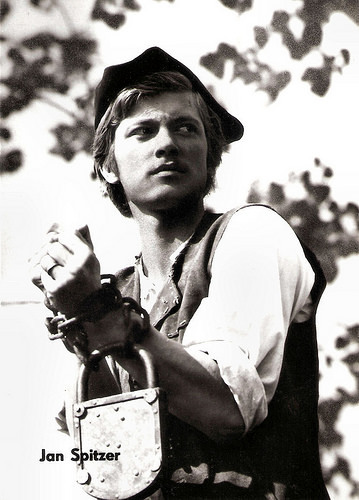
East-German postcard by VEB Progress Film-Vertrieb, Berlin, no. 97/69. Photo: DEFA / Karin Blasig. Publicity still for Jungfer, Sie gefällt mir/Maiden, I like you (Günter Reisch, 1969).
Jan Spitzer sings Mädchen aus Berlin (Girl from Berlin) in an East German TV show in 1969. Source: Thyrathron (YouTube).
Sources: Deutsche Mugge.de (German), Wikipedia (German) and .

Big East-German card by VEB Progress Film-Vertrieb, Berlin, no. 192/70. Photo: Karin Blasig.
A farewell to his class and his family
Jan Spitzer was born in 1947 in Sangerhausen, Germany. He loved pop music and formed in 1963 of the amateur band The Sounds, which covered songs by The Beatles and The Rolling Stones .
Between 1965 and 1968 he studied acting at the Hochschule für Schauspielkunst ‘Ernst Busch’ in Berlin. As a student, he made his film debut in the anti-war film Abschied/Farewell (Egon Günther, 1968) with Rolf Ludwig. Spitzer played the leading role of a seventeen year-old Munich boy, who decides in 1914 that he will not take part in the First World War. This means a farewell to his class and his family.
He then appeared in the historical comedy Jungfer, Sie gefällt mir/Maiden, I like you (Günter Reisch, 1969) with Wolfgang Kieling and Monika Gabriel.
In 1970 he released the pop single, Wer bist du? (Who are you?) and in the next years he recorded more songs. He did not like the Schlager genre, so in 1975 he decided to focus on his acting career.
His first bigger role was in the family film Philipp, der Kleine/Little Philipp (Herrmann Zschoche, 1978) as the father of a little boy who wishes to be taller in order to be noticed by the others. Then he comes across a magical flute.
In the meanwhile, Spitzer worked for television and could be seen in several TV series and TV movies like Im Schlaraffenland/In the land of Cockaigne (Kurt Jung-Alsen, 1975) with Erwin Geschonneck and Katharina Thalbach , which was shown in cinema in other East-European countries. He also appeared in the Eastern Blauvogel/Bluebird (Ulrich Weiß, 1979). And he played Friedrich Engels in the TV series Marx und Engels - Stationen ihres Lebens/Marx and Engels – Stations of their lives (1978-1980) with Jürgen Reuter as Karl Marx.

East-German postcard by VEB Progress Film-Vertrieb, Berlin, no. 3246, 1968. Photo: DEFA / Ebert. Publicity still for Abschied/Farewell (Egon Günther, 1968).

East-German postcard by VEB Progress Film-Vertrieb, Berlin, no. 3270, 1968. Photo: DEFA / Ebert. Publicity still for Abschied/Farewell (Egon Günther, 1968).
The German voice of Rutger Hauer
Jan Spitzer played a supporting part in the film Bürgschaft für ein Jahr/Guarantee for one year (Herrmann Zschoche, 1981) with Kathrin Sass as a divorced woman in her late twenties who will soon be fully deprived of her custody rights for her three children, who already reside in a home for the displaced, due to many years of willful neglect. Sass won the Silver Bear for her role at the Berlin Filmfestival.
Spitzer played a leading role in the Soviet-East-German co-production Dve strochki melkim shriftom/Two Lines in Small Font (Vitaliy Melnikov, 1981). He also appeared in the Czech fantasy film Carovné dedictví/Magical heritage (Zdenek Zelenka, 1986) and in the Eastern Präriejäger in Mexiko: Benito Juarez/Bounty hunter in Mexico: Benito Juarez (Hans Knötzsch, 1988) starring Gojko Mitic .
On TV, he guest-starred in the popular Krimi series Polizeiruf 110/Police Call 110 (1984-1991). After the Wende, Spitzer mostly worked for television but also narrated video games and was the German voice of James Remar, Chris Cooper, Jon Voight, Rutger Hauer and Alan Arkin in international films.
His most recent feature film is the drama Mutterseelenallein/All Alone (Bernd Böhlich, 2005) about a mother (Katrin Sass) who is confronted with her son being suspected of having murdered a girl on a garbage dump. Spitzer played her ex-husband.
Jan Spitzer is also a stage actor and he had engagements in Altenburg, Halle, Schwerin, at the Deutschen Theater in Berlin, at the Volkstheater in Munich and the Berliner Ensemble.

East-German postcard by VEB Progress Film-Vertrieb, Berlin, no. 51/69. Photo: DEFA / Kreuss. Publicity still for Jungfer, Sie gefällt mir/Maiden, I like you (Günter Reisch, 1969).

East-German postcard by VEB Progress Film-Vertrieb, Berlin, no. 97/69. Photo: DEFA / Karin Blasig. Publicity still for Jungfer, Sie gefällt mir/Maiden, I like you (Günter Reisch, 1969).
Jan Spitzer sings Mädchen aus Berlin (Girl from Berlin) in an East German TV show in 1969. Source: Thyrathron (YouTube).
Sources: Deutsche Mugge.de (German), Wikipedia (German) and .
Published on January 30, 2018 22:00
January 29, 2018
Willy Walden and Piet Muyselaar
Dutch comedians Willy Walden (1905-2003) and Piet Muyselaar (1899-1978), aka the ladies Snip & Snap, were the stars of the Sleeswijk Revue which filled the biggest theatres of the Netherlands between 1937 and 1977. The duo also starred together on TV and in the film Sterren stralen overal/Stars Twinkle Everywhere (1953).
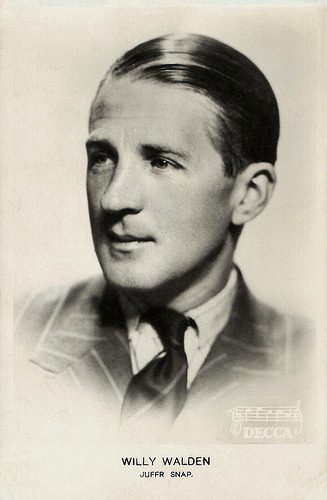
Willy Walden. Dutch postcard by Uitg. Handelsonderneming Triëm, Utrecht. Photo: Decca. Caption: Juffrouw Snap.
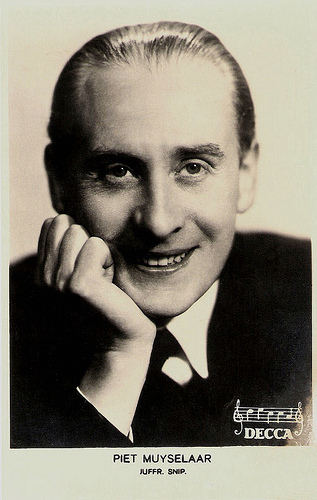
Piet Muyselaar. Dutch postcard by Uitg. Handelsonderneming Triëm, Utrecht. Photo: Decca.
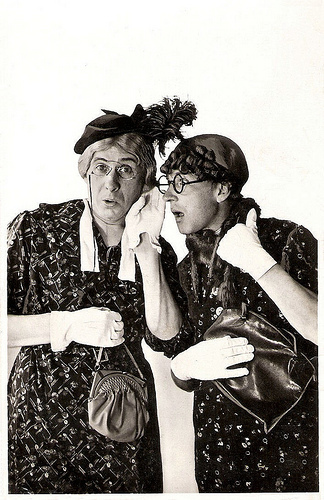
Dutch postcard by L. Nieweg, Amersfoort. Photo: W. Schuurman, Den Haag.
Bouwmeester Revue
Willy Walden was born as Herman Jan Jacob Kaldewaaij in Amsterdam in 1905. His brother would also become an artist, known as Gerard Walden.
During his youth, Willy was a good friend of the later film star Johan(nes) Heesters . In the 1920s they would appear together in a revue.
Willy Walden made his stage debut in 1927 with the Stapperrevue, in Hallo Parijs (Hello Paris). The stars were singer-comedian Louis Davids and the chansonniére Louisette. For the next years he often performed together with Davids. During the 1930s, he also performed with another great Dutch comedian of this era, Lou Bandy .
In 1935 he joined the Bouwmeester Revue, famous for its luxurious and spectacular outfits. Star of these revues was the clown Johan Buziau. One of the extras was Piet Muyselaar.
Piet Muyselaar was born in 1899 in Zaandam. He started his stage career at the Henvo-revues in Amsterdam. These revues, under the direction of Henk Voogd (HenVo), were small but popular. After a few years, Muyselaar was discovered by Louis Bouwmeester Jr., the director of the Bouwmeester-revues. He engaged Muyselaar reportedly while 'he could wear a tuxedo so well'.
Piet Muyselaar was indeed a true gentleman. He started as an extra, but soon his singing talents were discovered. In 1936 he appeared in the revue De lachende komedianten (The laughing comedians), next to Johan Buziau. Another extra was the comedian Willy Walden.
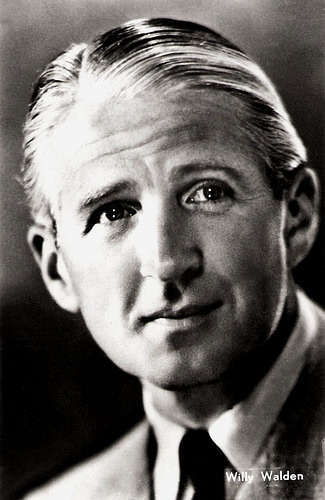
Willy Walden. Dutch collectors card.
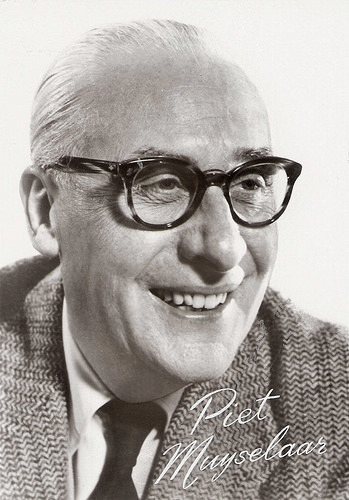
Piet Muyselaar. Dutch promocard.
Drag Act
In 1937 Willy Walden and Piet Muyselaar were brought together as a comic duo by chance. The radio show De Bonte Dinsdagavondtrein/The Colourful Tuesday Night Train was the most popular Dutch radio program of the era. The show presented amusement and cabaret, and was created by the young revue producer René Sleeswijk.
One legendary night, Sleeswijk had engaged Louis Davids , but the famous entertainer fell ill. Sleeswijk asked Muyselaar and Walden to appear together as a replacement. He also suggested them to do the sketch Juffrouw Snip en Juffrouw Snap/Miss Snip and Miss Snap, written by Davids and Jacques van Tol.
At first, Walden and Muyselaar didn’t like to do a drag act and thought the humor was silly, but finally they agreed to do it. Their crosstalks on stage were mostly improvisations. The radio public loved it, and two stars were born. Snip (Walden) & Snap (Muyselaar) became a Dutch phenomenon and the act would endure for four decades.
The first revue with the ladies Snip and Snap was a promotour for radio broadcaster AVRO. After a year this show evolved into the Snip & Snap Revue, under the direction of René Sleeswijk. In 1938, Snip & Snap made their first recordings, including Ja, meneer (Yes, Sir), a parody on the popular Zarah Leander song, and Snap je dat nou, juffrouw Snip (Do You Understand that, miss Snip).
During the Second World War, the revues were continued, like most of the Dutch theatre activities. Piet Muyselaar was married to revue actress Serah van der Heijm. She was Jewish and during the war the couple divorced formally. Serah was hidden in the house of Piet Muyselaar and survived thus the holocaust. After the war the couple remarried.
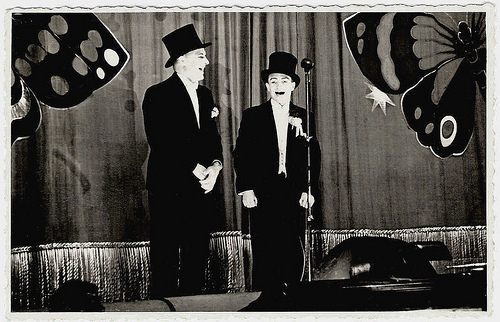
Dutch postcard by S. Oppelaar, Den Haag. On the flip side is written: Snip en Snap Amasitia Brabant feest 15 jaar bestaan (Snip & Snap Amasitia Brabant party 15 year jubilee). However, I'm not sure if this information is correct. Probably Amasitia is misspelled and must be Amicitia, a venue in Landsmeer. And I also wonder if the artists are really Willy Walden and Piet Muyselaar or imitators. It the caption refers to the 15 year jubilee of Snip & Snap, the picture is probably taken in 1952.
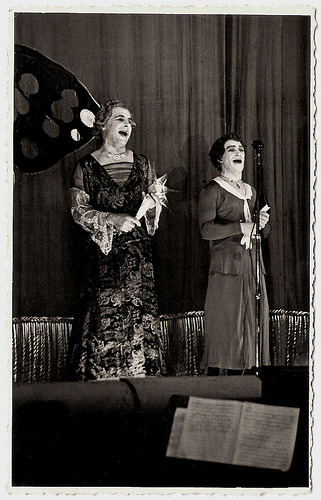
Dutch postcard by S. Oppelaar, Den Haag. Are the artists really Willy Walden and Piet Muyselaar or Snip and Snap imitators?
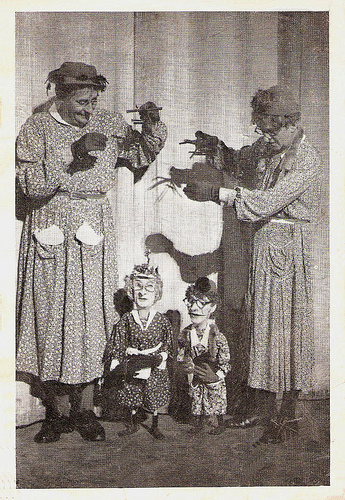
Dutch postcard. Sent by mail in 1955. Publicity still for the Snip and Snap revue Hollandse Nieuwe/Dutch Newest in Carré, Amsterdam.
Lots of feathers, glitter and glam
In the post-war years, the Snip & Snap revue became immensely popular in the Netherlands. For the Netherlands (our country is small and calvinistic), those revues were incredible spectacles with beautiful showgirls, an orchestra, big sets and lots of feathers, glitter and glam.
Willy Walden developed into a great comedian with superb mimicry and perfect timing. Muyselaar was perfect as his distinguished sidekick who could also sing well.
They starred in a popular film, Sterren stralen overal/Stars Twinkle Everywhere (Gerard Rutten, 1953) with Johan Kaart . The subject was the then actual item of Dutch emigration to Canada and Australia. For the comic interludes, producer Rudi Meyer engaged Walden and Muyselaar and also the complete cast of the Snip & Snap revue. The film became a success with more than 1 million visitors. (More than one tenth of the Dutch population in 1953!).
The following year, the Snip & Snap Revue was broadcasted on Dutch television. This would become a popular tradition. In 1977 Walden and Muyselaar performed for the last time together. Piet Muyselaar died a half year later, at age 78.
Willy Walden was married twice. His second wife was the Danish actress Aase Rasmussen who often appeared in the Snip & Snap revues. Willy and Aase presented the radio show Raad een lied (of niet)/Guess the Song (or Not) till 1987. Then they retired after their 500th show.
Willy Walden wrote his memoirs, published as Ja, dat was revue (Yes, that was revue). He died in 2003 in Bennekom, two weeks before his 98th birthday.
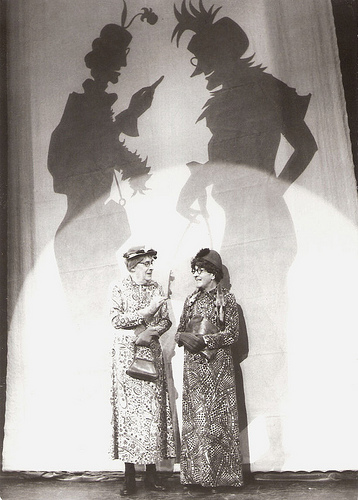
Dutch promocard, ca. 1980.
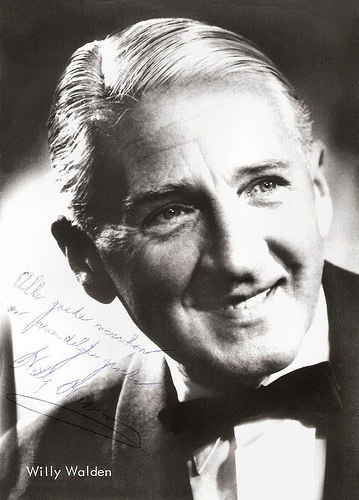
Willy Walden. Dutch autograph card.
Promo for the DVD Snip en Snap Proficiat. Source: Source 1 Media (YouTube).
Source: Aart Laferte (Aart Laferte’s Sentimental Journey - Dutch), Coen Verbraak (Vrij Nederland - Dutch), Wikipedia (Dutch) and .

Willy Walden. Dutch postcard by Uitg. Handelsonderneming Triëm, Utrecht. Photo: Decca. Caption: Juffrouw Snap.

Piet Muyselaar. Dutch postcard by Uitg. Handelsonderneming Triëm, Utrecht. Photo: Decca.

Dutch postcard by L. Nieweg, Amersfoort. Photo: W. Schuurman, Den Haag.
Bouwmeester Revue
Willy Walden was born as Herman Jan Jacob Kaldewaaij in Amsterdam in 1905. His brother would also become an artist, known as Gerard Walden.
During his youth, Willy was a good friend of the later film star Johan(nes) Heesters . In the 1920s they would appear together in a revue.
Willy Walden made his stage debut in 1927 with the Stapperrevue, in Hallo Parijs (Hello Paris). The stars were singer-comedian Louis Davids and the chansonniére Louisette. For the next years he often performed together with Davids. During the 1930s, he also performed with another great Dutch comedian of this era, Lou Bandy .
In 1935 he joined the Bouwmeester Revue, famous for its luxurious and spectacular outfits. Star of these revues was the clown Johan Buziau. One of the extras was Piet Muyselaar.
Piet Muyselaar was born in 1899 in Zaandam. He started his stage career at the Henvo-revues in Amsterdam. These revues, under the direction of Henk Voogd (HenVo), were small but popular. After a few years, Muyselaar was discovered by Louis Bouwmeester Jr., the director of the Bouwmeester-revues. He engaged Muyselaar reportedly while 'he could wear a tuxedo so well'.
Piet Muyselaar was indeed a true gentleman. He started as an extra, but soon his singing talents were discovered. In 1936 he appeared in the revue De lachende komedianten (The laughing comedians), next to Johan Buziau. Another extra was the comedian Willy Walden.

Willy Walden. Dutch collectors card.

Piet Muyselaar. Dutch promocard.
Drag Act
In 1937 Willy Walden and Piet Muyselaar were brought together as a comic duo by chance. The radio show De Bonte Dinsdagavondtrein/The Colourful Tuesday Night Train was the most popular Dutch radio program of the era. The show presented amusement and cabaret, and was created by the young revue producer René Sleeswijk.
One legendary night, Sleeswijk had engaged Louis Davids , but the famous entertainer fell ill. Sleeswijk asked Muyselaar and Walden to appear together as a replacement. He also suggested them to do the sketch Juffrouw Snip en Juffrouw Snap/Miss Snip and Miss Snap, written by Davids and Jacques van Tol.
At first, Walden and Muyselaar didn’t like to do a drag act and thought the humor was silly, but finally they agreed to do it. Their crosstalks on stage were mostly improvisations. The radio public loved it, and two stars were born. Snip (Walden) & Snap (Muyselaar) became a Dutch phenomenon and the act would endure for four decades.
The first revue with the ladies Snip and Snap was a promotour for radio broadcaster AVRO. After a year this show evolved into the Snip & Snap Revue, under the direction of René Sleeswijk. In 1938, Snip & Snap made their first recordings, including Ja, meneer (Yes, Sir), a parody on the popular Zarah Leander song, and Snap je dat nou, juffrouw Snip (Do You Understand that, miss Snip).
During the Second World War, the revues were continued, like most of the Dutch theatre activities. Piet Muyselaar was married to revue actress Serah van der Heijm. She was Jewish and during the war the couple divorced formally. Serah was hidden in the house of Piet Muyselaar and survived thus the holocaust. After the war the couple remarried.

Dutch postcard by S. Oppelaar, Den Haag. On the flip side is written: Snip en Snap Amasitia Brabant feest 15 jaar bestaan (Snip & Snap Amasitia Brabant party 15 year jubilee). However, I'm not sure if this information is correct. Probably Amasitia is misspelled and must be Amicitia, a venue in Landsmeer. And I also wonder if the artists are really Willy Walden and Piet Muyselaar or imitators. It the caption refers to the 15 year jubilee of Snip & Snap, the picture is probably taken in 1952.

Dutch postcard by S. Oppelaar, Den Haag. Are the artists really Willy Walden and Piet Muyselaar or Snip and Snap imitators?

Dutch postcard. Sent by mail in 1955. Publicity still for the Snip and Snap revue Hollandse Nieuwe/Dutch Newest in Carré, Amsterdam.
Lots of feathers, glitter and glam
In the post-war years, the Snip & Snap revue became immensely popular in the Netherlands. For the Netherlands (our country is small and calvinistic), those revues were incredible spectacles with beautiful showgirls, an orchestra, big sets and lots of feathers, glitter and glam.
Willy Walden developed into a great comedian with superb mimicry and perfect timing. Muyselaar was perfect as his distinguished sidekick who could also sing well.
They starred in a popular film, Sterren stralen overal/Stars Twinkle Everywhere (Gerard Rutten, 1953) with Johan Kaart . The subject was the then actual item of Dutch emigration to Canada and Australia. For the comic interludes, producer Rudi Meyer engaged Walden and Muyselaar and also the complete cast of the Snip & Snap revue. The film became a success with more than 1 million visitors. (More than one tenth of the Dutch population in 1953!).
The following year, the Snip & Snap Revue was broadcasted on Dutch television. This would become a popular tradition. In 1977 Walden and Muyselaar performed for the last time together. Piet Muyselaar died a half year later, at age 78.
Willy Walden was married twice. His second wife was the Danish actress Aase Rasmussen who often appeared in the Snip & Snap revues. Willy and Aase presented the radio show Raad een lied (of niet)/Guess the Song (or Not) till 1987. Then they retired after their 500th show.
Willy Walden wrote his memoirs, published as Ja, dat was revue (Yes, that was revue). He died in 2003 in Bennekom, two weeks before his 98th birthday.

Dutch promocard, ca. 1980.

Willy Walden. Dutch autograph card.
Promo for the DVD Snip en Snap Proficiat. Source: Source 1 Media (YouTube).
Source: Aart Laferte (Aart Laferte’s Sentimental Journey - Dutch), Coen Verbraak (Vrij Nederland - Dutch), Wikipedia (Dutch) and .
Published on January 29, 2018 22:00
January 28, 2018
Lilian Braithwaite
Beautiful English actress Lilian Braithwaite (1873-1948) worked primarily on the stage, but she also appeared in films like Alfred Hitchcock’s Downhill (1927).
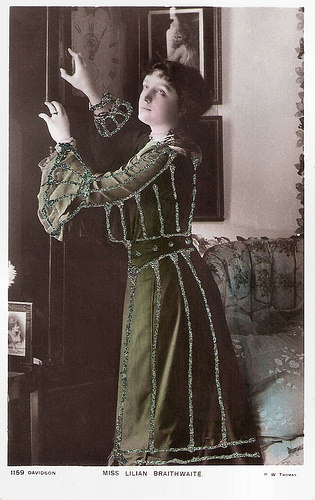
British postcard by Davidson Bros. in the Glossyphoto Series, no. 1159. Photo: R.W. Thomas.
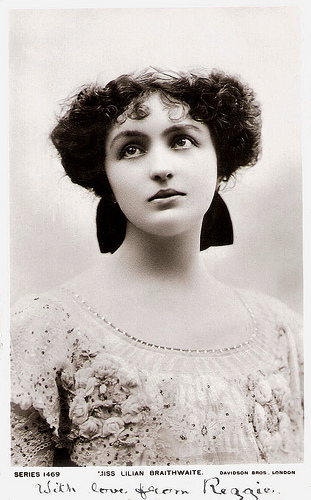
British postcard in the Glossyphoto series by Davidson Bros, London, Series 1469.
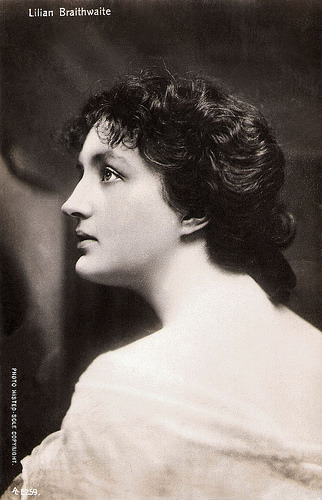
German postcard by AL 259. Photo: Histed. Sent by mail in the Netherlands in 1906.
The second most beautiful woman in London
Dame Florence Lilian Braithwaite DBE was born in Ramsgate, Kent in 1873. She was the daughter of Rev. John M. Braithwaite (vicar of St. Michaels, Maidstone) and his wife Elizabeth (née Powell). Lilian was educated at Croydon High School.
She first acted with amateur companies. Her first professional London appearance was in As You Like It in 1900. Lilian Braithwaite responded to the assertion of critic James Agate that she was "the second most beautiful woman in London", by replying, "I shall long cherish that, coming from our second-best theatre critic."
Braithwaite appeared also in several silent films. She started in productions like the drama The World's Desire (Sidney Morgan, 1915). In the crime film Justice (Maurice Elvey, 1917), she co-starred with Gerald du Maurier, and in the Charles Dickens adaptation Dombey and Son (Maurice Elvey, 1917) with Mary Odette .
The drama Because (Sidney Morgan, 1918) is about a father who locks his daughter up when she refuses to marry the man he has chosen as her husband. She then co-starred with C. Aubrey Smith in Castles in Spain (Horace Lisle Lucoque, 1920). She also worked with Betty Balfour on the drama Mary Find the Gold (George Pearson, 1921).
However, Lilian Braithwaite's best known film role was as schoolboy Ivor Novello ’s mother in Downhill (Alfred Hitchcock, 1927). The film is based on the play, Down Hill, written by Novello and Constance Collier under the combined alias David L'Estrange. Hitchcock's emerging style is well demonstrated in this film. He experimented with dream sequences by shooting them in super impositions and blurred images. He also played with shadow and light in much the same way as directors of German expressionist films of the time.
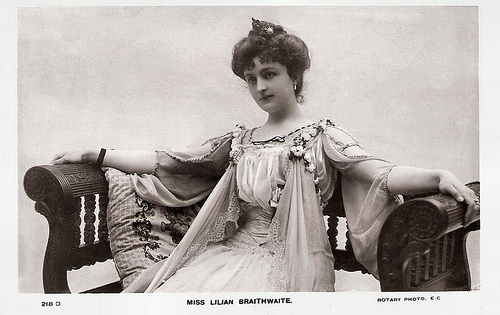
British postcard in the Rotary Photographic series, no. 218 O.
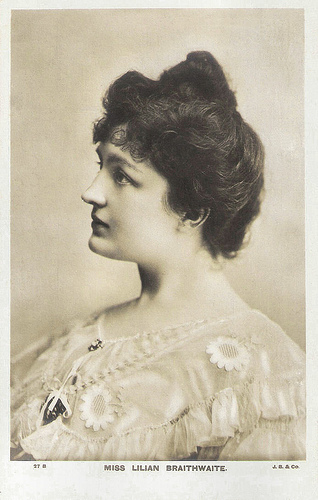
British postcard by J. Beagles & Co., London, no. 27 B.
Comedy was her greatest asset
During the 1930s, Lilian Braithwaite played supporting parts in sound films such as the musical comedy A Man of Mayfair (Louis Mercanton, 1931) starring Jack Buchanan , the crime film The Chinese Puzzle (Guy Newall, 1932) with Elizabeth Allan , and the drama Moscow Nights (Anthony Asquith, 1935) starring Laurence Olivier and Harry Baur .
Her greatest triumph was on stage as the alcoholic mother in Noël Coward's groundbreaking drama The Vortex. The play depicts the sexual vanity of a rich, ageing beauty, her troubled relationship with her adult son, and drug abuse in British society circles after the First World War. The son's cocaine habit is seen by many critics as a metaphor for homosexuality, then taboo in Britain. Despite, or because of, its controversial content for the time, the play was Coward's first great commercial success.
Braithwaite proved that comedy was her greatest asset in a long succession of drawing-room dramas and light comedies, culminating in the long running stage hit Arsenic and Old Lace (1942-1946), a a farcical black comedy by the American playwright Joseph Kesselring.
During the Second World War she served as chairman and chief organiser of the hospital division of the Entertainments National Service Association (ENSA). She was appointed a Dame Commander of the Order of the British Empire (DBE), for services to the stage, on 1 January 1943.
After the war she appeared in her final film, the melodrama A Man About the House (Leslie Arliss, 1947), starring Dulcie Gray and Kieran Moore .
Braithwaite was married to actor-manager Gerald Lawrence. The couple divorced in 1905. She and Lawrence had a daughter, Joyce Carey, who later became a film and television actress. Lilian Braitwaite died in 1948 in London at the age of 75.
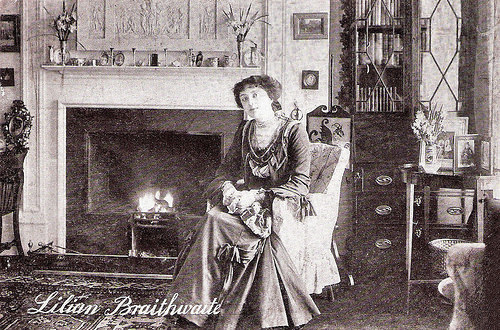
British postcard in the Yes or No series.
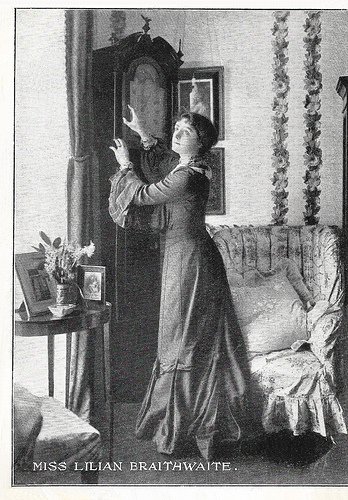
British postcard in the "Yes or No?" series. Photo: R.W. Thomas (see above).
Sources: Stage Beauty, Wikipedia and .

British postcard by Davidson Bros. in the Glossyphoto Series, no. 1159. Photo: R.W. Thomas.

British postcard in the Glossyphoto series by Davidson Bros, London, Series 1469.

German postcard by AL 259. Photo: Histed. Sent by mail in the Netherlands in 1906.
The second most beautiful woman in London
Dame Florence Lilian Braithwaite DBE was born in Ramsgate, Kent in 1873. She was the daughter of Rev. John M. Braithwaite (vicar of St. Michaels, Maidstone) and his wife Elizabeth (née Powell). Lilian was educated at Croydon High School.
She first acted with amateur companies. Her first professional London appearance was in As You Like It in 1900. Lilian Braithwaite responded to the assertion of critic James Agate that she was "the second most beautiful woman in London", by replying, "I shall long cherish that, coming from our second-best theatre critic."
Braithwaite appeared also in several silent films. She started in productions like the drama The World's Desire (Sidney Morgan, 1915). In the crime film Justice (Maurice Elvey, 1917), she co-starred with Gerald du Maurier, and in the Charles Dickens adaptation Dombey and Son (Maurice Elvey, 1917) with Mary Odette .
The drama Because (Sidney Morgan, 1918) is about a father who locks his daughter up when she refuses to marry the man he has chosen as her husband. She then co-starred with C. Aubrey Smith in Castles in Spain (Horace Lisle Lucoque, 1920). She also worked with Betty Balfour on the drama Mary Find the Gold (George Pearson, 1921).
However, Lilian Braithwaite's best known film role was as schoolboy Ivor Novello ’s mother in Downhill (Alfred Hitchcock, 1927). The film is based on the play, Down Hill, written by Novello and Constance Collier under the combined alias David L'Estrange. Hitchcock's emerging style is well demonstrated in this film. He experimented with dream sequences by shooting them in super impositions and blurred images. He also played with shadow and light in much the same way as directors of German expressionist films of the time.

British postcard in the Rotary Photographic series, no. 218 O.

British postcard by J. Beagles & Co., London, no. 27 B.
Comedy was her greatest asset
During the 1930s, Lilian Braithwaite played supporting parts in sound films such as the musical comedy A Man of Mayfair (Louis Mercanton, 1931) starring Jack Buchanan , the crime film The Chinese Puzzle (Guy Newall, 1932) with Elizabeth Allan , and the drama Moscow Nights (Anthony Asquith, 1935) starring Laurence Olivier and Harry Baur .
Her greatest triumph was on stage as the alcoholic mother in Noël Coward's groundbreaking drama The Vortex. The play depicts the sexual vanity of a rich, ageing beauty, her troubled relationship with her adult son, and drug abuse in British society circles after the First World War. The son's cocaine habit is seen by many critics as a metaphor for homosexuality, then taboo in Britain. Despite, or because of, its controversial content for the time, the play was Coward's first great commercial success.
Braithwaite proved that comedy was her greatest asset in a long succession of drawing-room dramas and light comedies, culminating in the long running stage hit Arsenic and Old Lace (1942-1946), a a farcical black comedy by the American playwright Joseph Kesselring.
During the Second World War she served as chairman and chief organiser of the hospital division of the Entertainments National Service Association (ENSA). She was appointed a Dame Commander of the Order of the British Empire (DBE), for services to the stage, on 1 January 1943.
After the war she appeared in her final film, the melodrama A Man About the House (Leslie Arliss, 1947), starring Dulcie Gray and Kieran Moore .
Braithwaite was married to actor-manager Gerald Lawrence. The couple divorced in 1905. She and Lawrence had a daughter, Joyce Carey, who later became a film and television actress. Lilian Braitwaite died in 1948 in London at the age of 75.

British postcard in the Yes or No series.

British postcard in the "Yes or No?" series. Photo: R.W. Thomas (see above).
Sources: Stage Beauty, Wikipedia and .
Published on January 28, 2018 22:00
January 27, 2018
Gusti Huber
Gusti Huber (1914-1993) was an Austrian stage and film actress. She was a popular actress in the cinema of Nazi-Germany. In 1946 she moved with her American husband to the US and continued her career on Broadway. She played Anne Frank's mother in the Pulitzer Prize winning play The Diary of Anne Frank and later also in the film version.
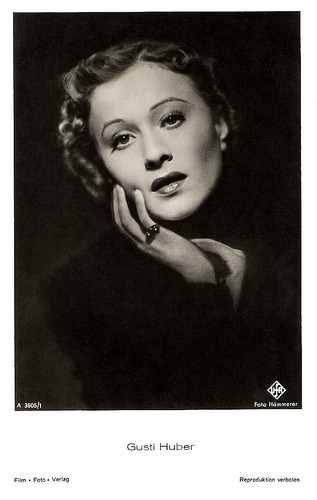
German postcard by Ross-Verlag, no. A 3605/1, 1941-1944. Photo: Ufa / Hämmerer.
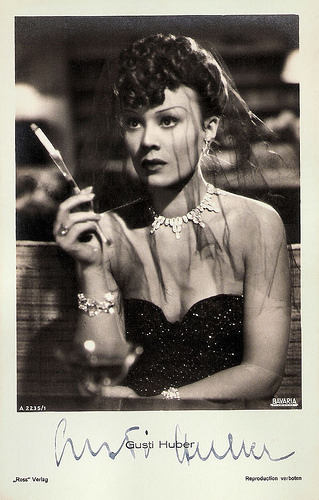
German postcard by Ross-Verlag, no. A 2235/1, 1939-1940. Photo: Bavaria Filmkunst.
Land of Love
Auguste ‘Gusti’ Huber was born in Wiener Neustadt, Austria in 1914. She studied at the Academy for Music and Representative Art in Vienna.
During her studies she began her acting career in 1929 at the Deutsches Volkstheater. She joined the Schauspielhaus in Zurich, where she played more than 180 roles in a five-year period.
In 1935, she had her first film role in the Austrian drama Tanzmusik/Dance Music (Johann Alexander Hübler-Kahla, 1935), starring Liane Haid . Her debut was followed by the German drama Savoy-Hotel 217 (Gustav Ucicky, 1936) with Hans Albers and Brigitte Horney .
One year later she achieved her career breakthrough in the film adaptation of Unentschuldigte Stunde/The Unexcused Hour (E.W. Emo, 1937) as the daughter of Hans Moser and Dagny Servaes.
That year she also appeared opposite Albert Matterstock in the romance Land der Liebe/Land of Love (Reinhold Schünzel, 1937). Although Schünzel was Jewish he had been allowed to continue directing films in Germany after the Nazi takeover. However, this film faced objections from the censors and from Joseph Goebbels. It was briefly shown and then disappeared from cinemas. It was Schünzel's final German film as director, and he went into exile shortly afterwards.
Among Huber’s better-known films were also Kleiner Mann - ganz gross!/Little man - very big! (Robert A. Stemmle, 1938) with Viktor de Kowa, the comedy Marguerite : 3 (Theo Lingen, 1939), and Herz - modern möbliert/Heart - modernly furnished (Theo Lingen, 1940).
During the war, she starred in a few films including Jenny und der Herr im Frack/Jenny as Detective (Paul Martin, 1941) with Johannes Heesters , and Gabriele Dambrone (Hans Steinhoff, 1943) with Siegfried Breuer . During this period she worked mostly at the famous Burgtheater in Vienna.
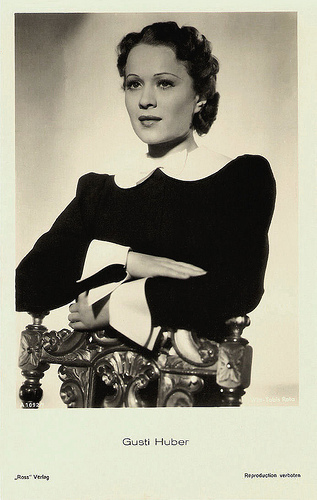
German postcard by Ross Verlag, no. A 1092/1, 1937-1938. Photo: Witt / Tobis / Rota.
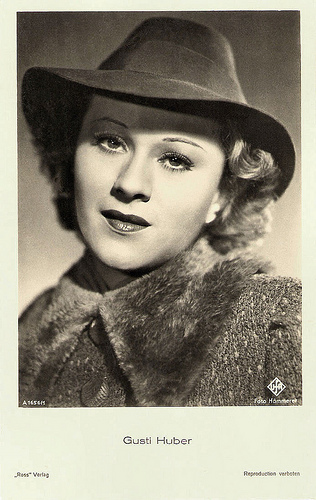
German postcard by Ross Verlag, no. A 1656/1, 1938-1939. Photo: Ufa / Hämmerer.
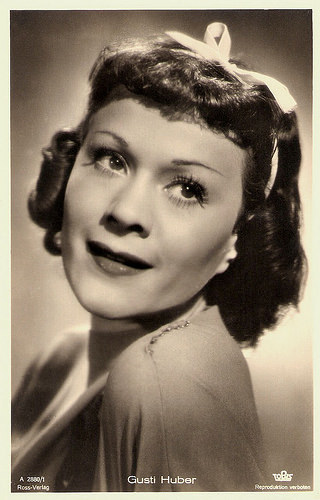
German postcard by Ross-Verlag, no. A 2880/1, 1939-1940. Photo: Tobis.
The first Austrian actress to be cleared by the American military government
After the liberation of Austria in World War II, Gusti Huber joined a company entertaining American troops. She met and married Joseph Besch, a United States Army captain and former newspaperman. Around 1946, the couple moved to the United States. Besch boasted that his wife was "the first Austrian actress to be cleared by the American military government".
She acted only occasionally thereafter. In 1952, she made her American debut on Broadway in Flight Into Egypt, the story of an Austrian refugee family struggling to get to America, directed by Elia Kazan.
On TV she appeared in episodes of such series as Suspense (1952) and The Further Adventures of Ellery Queen (1959). Most notably were her roles on Broadway such as Margot Wendice in Dial M for Murder, and Anne Frank's mother, Edith in the Pulitzer Prize winning play The Diary of Anne Frank, adapted by Frances Goodrich and Albert Hackett.
Her last film was The Diary of Anne Frank (George Stevens, 1959), in which she reprised her Broadway role. This caused controversy in some circles as Huber was rumoured to have been too close to the National Socialists, but Garson Kanin who had staged the Broadway play reportedly stood by the casting.
Ellen Feldman at American Heritage: “In Vienna before the war she [Huber] had refused to work with a Jewish actor and director [if so, Huber did work under the Nazis with the Jewish director Reinhold Schünzel , EFSP], and in Germany during the war she had continued to make movies under the Third Reich. But Huber was a Broadway star and [the charges against her] never ... gained traction.”
The Diary of Anne Frank won three Academy Awards in 1960. After retiring from acting in 1961, Huber lectured in New York area high schools on the legacy of Anne Frank, the Jewish girl who hid from the Nazis in a garret in Amsterdam and who died in a concentration camp shortly before the end of World War II.
In 1993, Gusti Huber passed away at her home in Mount Kisco, N.Y. The cause was heart failure. She was 78. Huber was married twice. Her first husband was Gotfrid Köchert, an Austrian racing driver, who served in the Wehrmacht during World War II. They had two children, Bibiana Maria (1942-1996), who, known as Bibi Besch, was a successful actress during the 1970s and 1980s, and Christiana Barbara (1939-2004). Her second husband, Joseph Besch, adopted Huber's daughters, who took his surname. Besch and Huber had two more children, Drea and Andrew. Actress Samantha Mathis, Bibi's daughter, is one of Gusti Huber’s grandchildren.
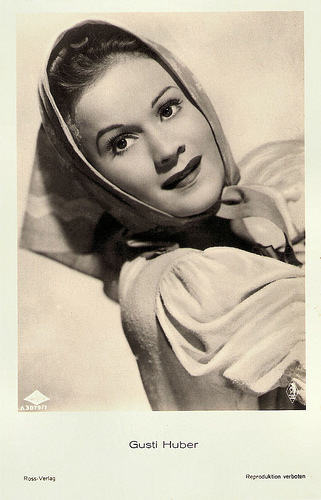
German postcard by Ross-Verlag, no. A 3075/1, 1941-1944. Photo: Wien-Film / Bavaria Film-Kunst. Publicity still for So gefällst Du mir/I like you that way (Hans Thimig, 1941).
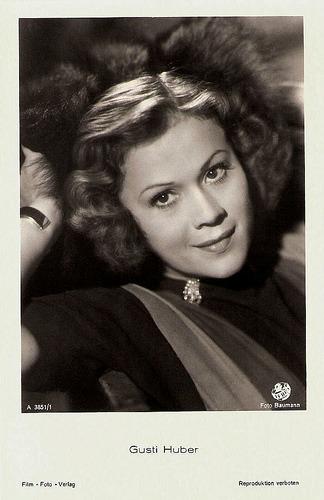
German postcard by Film-Foto-Verlag, no. A 3851/1, 1941-1944. Photo: Baumann / Terra.
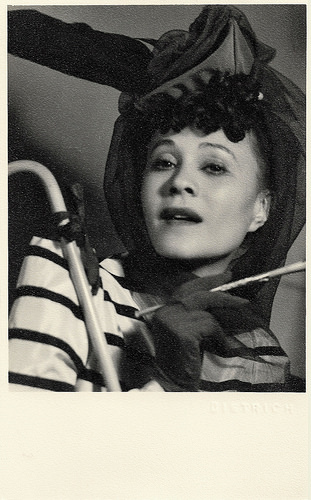
German postcard, no. 68252. Photo: Dietrich. Publicity still for the play Ich liebe vier Frauen/I love four women.
Sources: Ellen Feldman (American Heritage), Marvine Howe (The New York Times), Thomas Staedeli (Cyranos), Wikipedia and .

German postcard by Ross-Verlag, no. A 3605/1, 1941-1944. Photo: Ufa / Hämmerer.

German postcard by Ross-Verlag, no. A 2235/1, 1939-1940. Photo: Bavaria Filmkunst.
Land of Love
Auguste ‘Gusti’ Huber was born in Wiener Neustadt, Austria in 1914. She studied at the Academy for Music and Representative Art in Vienna.
During her studies she began her acting career in 1929 at the Deutsches Volkstheater. She joined the Schauspielhaus in Zurich, where she played more than 180 roles in a five-year period.
In 1935, she had her first film role in the Austrian drama Tanzmusik/Dance Music (Johann Alexander Hübler-Kahla, 1935), starring Liane Haid . Her debut was followed by the German drama Savoy-Hotel 217 (Gustav Ucicky, 1936) with Hans Albers and Brigitte Horney .
One year later she achieved her career breakthrough in the film adaptation of Unentschuldigte Stunde/The Unexcused Hour (E.W. Emo, 1937) as the daughter of Hans Moser and Dagny Servaes.
That year she also appeared opposite Albert Matterstock in the romance Land der Liebe/Land of Love (Reinhold Schünzel, 1937). Although Schünzel was Jewish he had been allowed to continue directing films in Germany after the Nazi takeover. However, this film faced objections from the censors and from Joseph Goebbels. It was briefly shown and then disappeared from cinemas. It was Schünzel's final German film as director, and he went into exile shortly afterwards.
Among Huber’s better-known films were also Kleiner Mann - ganz gross!/Little man - very big! (Robert A. Stemmle, 1938) with Viktor de Kowa, the comedy Marguerite : 3 (Theo Lingen, 1939), and Herz - modern möbliert/Heart - modernly furnished (Theo Lingen, 1940).
During the war, she starred in a few films including Jenny und der Herr im Frack/Jenny as Detective (Paul Martin, 1941) with Johannes Heesters , and Gabriele Dambrone (Hans Steinhoff, 1943) with Siegfried Breuer . During this period she worked mostly at the famous Burgtheater in Vienna.

German postcard by Ross Verlag, no. A 1092/1, 1937-1938. Photo: Witt / Tobis / Rota.

German postcard by Ross Verlag, no. A 1656/1, 1938-1939. Photo: Ufa / Hämmerer.

German postcard by Ross-Verlag, no. A 2880/1, 1939-1940. Photo: Tobis.
The first Austrian actress to be cleared by the American military government
After the liberation of Austria in World War II, Gusti Huber joined a company entertaining American troops. She met and married Joseph Besch, a United States Army captain and former newspaperman. Around 1946, the couple moved to the United States. Besch boasted that his wife was "the first Austrian actress to be cleared by the American military government".
She acted only occasionally thereafter. In 1952, she made her American debut on Broadway in Flight Into Egypt, the story of an Austrian refugee family struggling to get to America, directed by Elia Kazan.
On TV she appeared in episodes of such series as Suspense (1952) and The Further Adventures of Ellery Queen (1959). Most notably were her roles on Broadway such as Margot Wendice in Dial M for Murder, and Anne Frank's mother, Edith in the Pulitzer Prize winning play The Diary of Anne Frank, adapted by Frances Goodrich and Albert Hackett.
Her last film was The Diary of Anne Frank (George Stevens, 1959), in which she reprised her Broadway role. This caused controversy in some circles as Huber was rumoured to have been too close to the National Socialists, but Garson Kanin who had staged the Broadway play reportedly stood by the casting.
Ellen Feldman at American Heritage: “In Vienna before the war she [Huber] had refused to work with a Jewish actor and director [if so, Huber did work under the Nazis with the Jewish director Reinhold Schünzel , EFSP], and in Germany during the war she had continued to make movies under the Third Reich. But Huber was a Broadway star and [the charges against her] never ... gained traction.”
The Diary of Anne Frank won three Academy Awards in 1960. After retiring from acting in 1961, Huber lectured in New York area high schools on the legacy of Anne Frank, the Jewish girl who hid from the Nazis in a garret in Amsterdam and who died in a concentration camp shortly before the end of World War II.
In 1993, Gusti Huber passed away at her home in Mount Kisco, N.Y. The cause was heart failure. She was 78. Huber was married twice. Her first husband was Gotfrid Köchert, an Austrian racing driver, who served in the Wehrmacht during World War II. They had two children, Bibiana Maria (1942-1996), who, known as Bibi Besch, was a successful actress during the 1970s and 1980s, and Christiana Barbara (1939-2004). Her second husband, Joseph Besch, adopted Huber's daughters, who took his surname. Besch and Huber had two more children, Drea and Andrew. Actress Samantha Mathis, Bibi's daughter, is one of Gusti Huber’s grandchildren.

German postcard by Ross-Verlag, no. A 3075/1, 1941-1944. Photo: Wien-Film / Bavaria Film-Kunst. Publicity still for So gefällst Du mir/I like you that way (Hans Thimig, 1941).

German postcard by Film-Foto-Verlag, no. A 3851/1, 1941-1944. Photo: Baumann / Terra.

German postcard, no. 68252. Photo: Dietrich. Publicity still for the play Ich liebe vier Frauen/I love four women.
Sources: Ellen Feldman (American Heritage), Marvine Howe (The New York Times), Thomas Staedeli (Cyranos), Wikipedia and .
Published on January 27, 2018 22:00
January 26, 2018
Iya Savvina
Soviet film actress Iya Savvina (1936-2011) was named a People's Artist of the USSR in 1990. She appeared in 30 films following her star turn as Anna Sergeyevna in Iosif Kheifets's Dama s sobachkoy/The Lady with the Little Dog (1960).
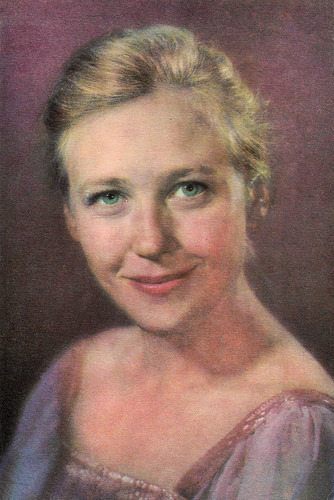
Soviet postcard, no M-59012, 1967.
A long lost classic of Soviet cinema
Iya Sergeyevna Savvina (Russian: Ия Серге́евна Саввина) was born in 1936 in in Voronezh, Russia, Soviet Union (now Russia). She was not a professionally trained actress.
In 1958, she graduated from the Department of Journalism of the Moscow State University. While a student, Savvina was active in student drama club of the university. There she was spotted by casting directors from Lenfilm studios and made her film debut in Leningrad.
She had her breakthrough as Anna Sergeyevna opposite Aleksey Batalov in Dama s sobachkoy/The Lady with the Little Dog (Iosif Kheifets, 1960), based on the story by Anton Chekhov. The film was entered into the 1960 Cannes Film Festival.
Next she starred in the drama Krotkaya (Aleksandr Borisov, 1960), based on the short story A Gentle Being by Fyodor Dostoevsky. From 1960 till 1977, Savvina was a member of the Mossoveta theatre in Moscow.
In the cinema, she played the leading role in Istoriya Asi Klyachinoy, kotoraya lyubila, da ne vyshla zamuzh/The Story of Asya Klyachina (Andrei Konchalovsky,1966). Shown briefly in 1967 under the title Asya's Happiness, it was not released widely until 1987 when it was hailed (by Michail Gorbachev as a long lost classic of Soviet cinema.
Savvina played Dolly in Anna Karenina (Aleksandr Zarkhi, 1967) based on the novel of the same name by Leo Tolstoy. The film, starring Tatiana Samoilova as Anna Karenina and Vasili Lanovoy as Vronsky, was listed to compete at the 1968 Cannes Film Festival, but the festival was cancelled due to the events of May 1968 in France.
Savvina then played another supporting part in the war film Sluzhili dva tovarishcha/Two Comrades Were Serving (Yevgeni Karelov, 1968) starring Oleg Yankovsky. The film tells about the Russian civil war, in particular, the battle for the Crimean peninsula.
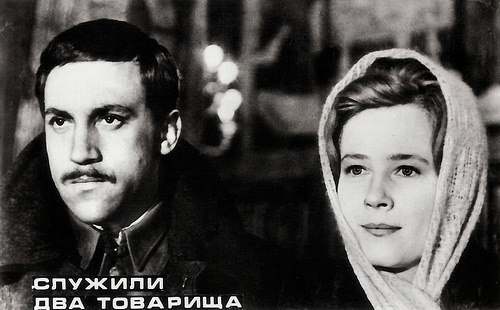
Soviet collectors card. Photo: publicity still for Sluzhili dva tovarishcha/Two Comrades Were Serving (Yevgeni Karelov, 1968) with Vladimir Vysotskiy.
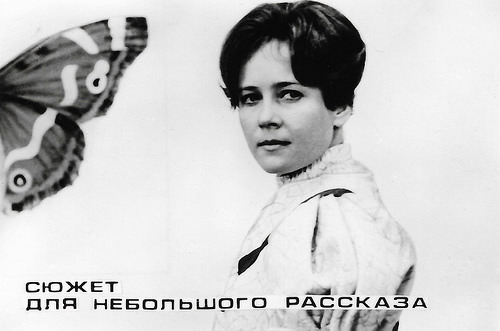
Soviet collectors card. Photo: publicity still for Syuzhet dlya nebolshogo rasskaza/Subject for a Short Story (Sergei Yutkevich, 1969).
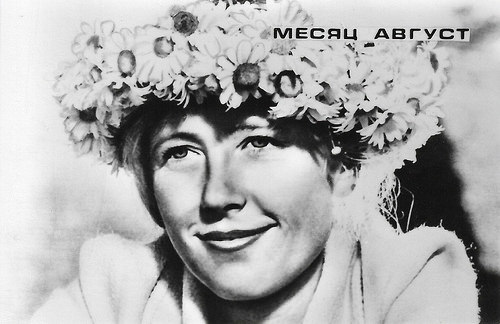
Soviet collectors card. Photo: publicity still for Mesyats avgust/The month of August (Vadim Mikhaylov, 1972).
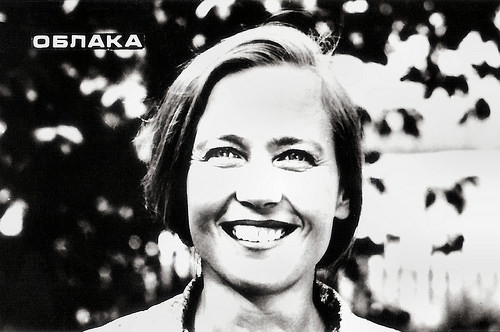
Soviet collectors card. Photo: publicity still for Oblaka/Clouds (Boris Stepanov, 1973).
People's Actress of the USSR
In Russia, Iya Savvina is also known for providing the voice of the Piglet in the Soviet animation version of Winnie-the-Pooh. Vinni-Pukh/Winnie-the-Pooh (Fyodor Khitruk, 1969). The short film is based on chapter one in the book series by A. A. Milne. It is the first part of a trilogy, along with two sequels: Vinni-Pukh idyot v gosti/Winnie-the-Pooh Pays a Visit (Fyodor Khitruk, 1971) and Vinni-Pukh i den zabot/Winnie-the-Pooh and a Busy Day (Fyodor Khitruk, 1972).
Savvina was a prominent actress by then, and director Fyodor Khitruk invited her merely to review his initial work, because he knew that Savvina was a big fan of the Winnie-the-Pooh story. Her records had to be sped up to change the tone of her voice (the same technique was used for the main character).
Then, she reunited with director Andrei Konchalovsly for the musical romantic drama Romans o vlyublyonnykh/A Lover's Romance (Andrei Konchalovsky, 1974). Since 1977, Iya Savvina worked for the Moscow Art Theatre (MKhAT). She made her best known stage appearances in Anton Chekhov's classic plays. She shone as Anfisa in Tri Sestry (The Three Sisters), and as Sharlotta in Vishnevy sad (The Cherry Orchard).
Savvina was also a notable memoirist and cinema scholar who wrote about her colleagues Faina Ranevskaya, Mikhail Ulyanov, Lyubov Orlova and others. Her later films include the comedy Garazh/The Garage (Eldar Ryazanov, 1980), the fantasy Slyozy kapali/Tears Were Falling (Georgiy Daneliya, 1982), a modern interpretation of the fairy tale The Snow Queen by Hans Christian Andersen, and the drama Chastnaya zhizn/Private Life (Yuli Raizman, 1982), which was nominated for the Academy Award for Best Foreign Language Film in 1982.
Her final film was Slushaya tishinu/Listen to the silence (Aleksandr Kasatkin, 2007). In 1990, Savvina was designated People's Actress of the USSR. She was awarded the State Prize of the USSR twice (1983, 1990), and received numerous awards from the Soviet and Russian government.
In 2011, Iya Savvina passed away in Moscow. She was 75. Savvina had been married to Vsevolod Shestakov, a prominent geologist and amateur stage actor. Their son Sergey was born in 1957 with the Down syndrome, yet became a professional graphical artist and Russian-English translator. Savvina and Shestakov divorced in 1974. In August 2011, two weeks before her death of skin cancer, Iya married her long-time companion, Anatoly Vasilyev, with whom she had a relationship for more than 30 years.
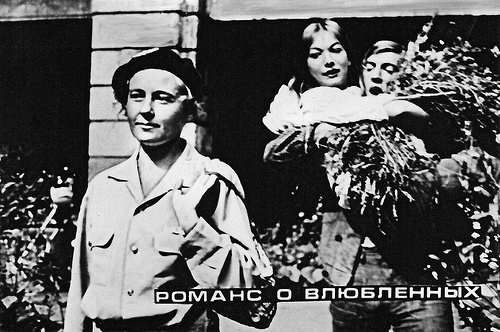
Soviet collectors card. Photo: publicity still for Romans o vlyublyonnykh/A Lover's Romance (Andrey Konchalovskiy, 1974) with Elena Koreneva and Evgeniy Kindinov.
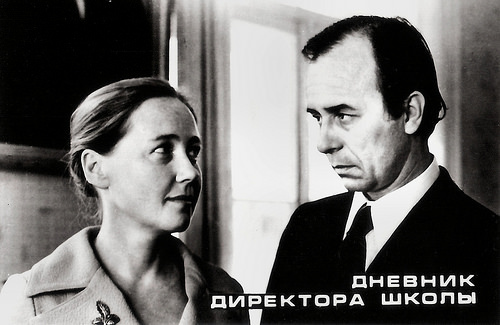
Soviet collectors card. Photo: publicity still for Dnevnik direktora shkoly/Diary of a School Director (Boris Frumin, 1975) with Oleg Borisov.
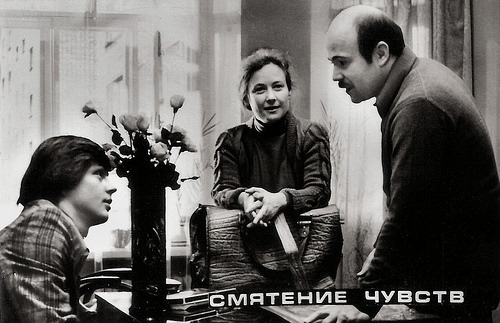
Soviet collectors card. Photo: publicity still for Smyatenie chuvstv/Confusion of feelings (Pavel Arsyonov, 1978) with Sergei Nagorny and Aleksandr Kalyagin.
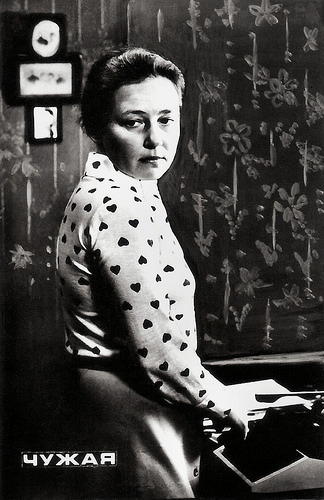
Soviet collectors card. Photo: publicity still for Chuzhaya/Alien (Vladimir Shredel, 1979).
Sources: (IMDb), Wikipedia and .
Published on January 26, 2018 22:00
January 25, 2018
Lux
Lux soap is now a global brand developed by Unilever, but it started as 'Sunlight Flakes' laundry soap in 1899. A year later, the name changed to 'Lux', the Latin word for 'light' and suggestive of 'luxury'. In 1925, it became the first mass-market toilet soap in the world. Since then, the brand concentrated on building its association with the increasingly popular film world, focusing more on film stars and their roles rather than on the product. In 1929, advertising featured 26 of the biggest female stars of the day, creating a huge impact among the filmgoers. Another example is this series of German film star collectors cards, produced in the 1950s with stars of the German cinema. These collectors cards have a printed autograph and are a bit smaller than normal postcards.
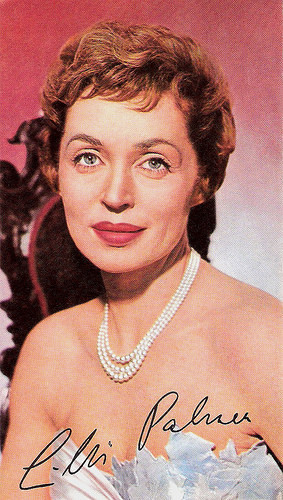
Lilli Palmer . German collectors card by Lux.
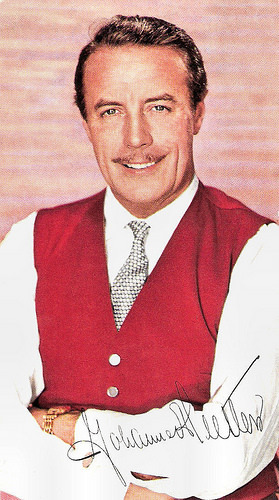
Johannes Heesters . German collectors card by Lux.
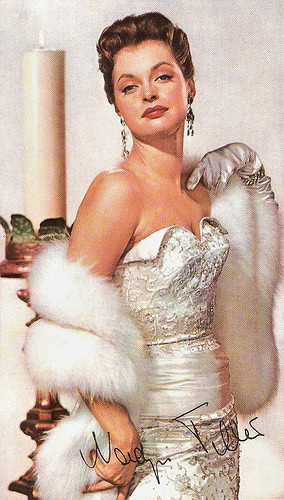
Nadja Tiller . German collectors card by Lux.
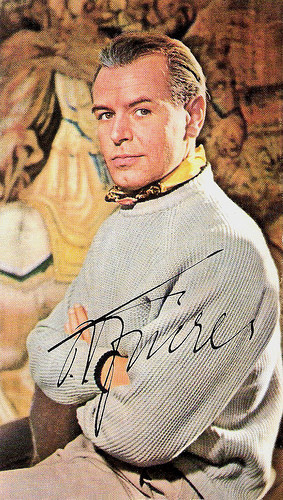
O.W. Fischer . German collectors card by Lux.
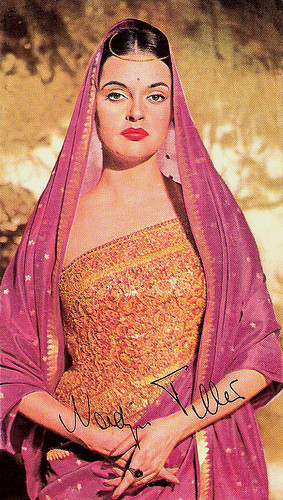
Nadja Tiller . German collectors card by Lux.
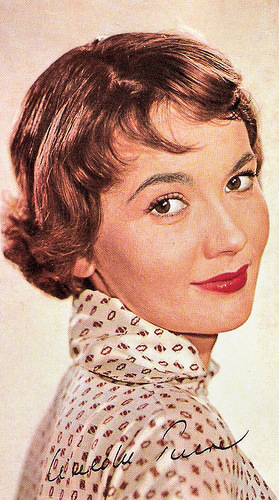
Liselotte Pulver . German collectors card by Lux.
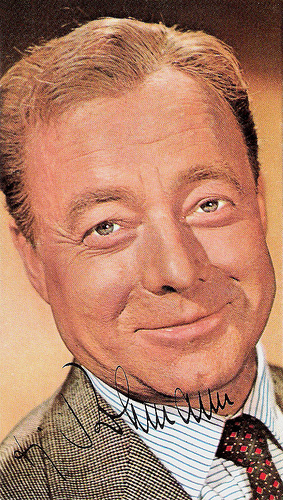
Heinz Rühmann . German collectors card by Lux.
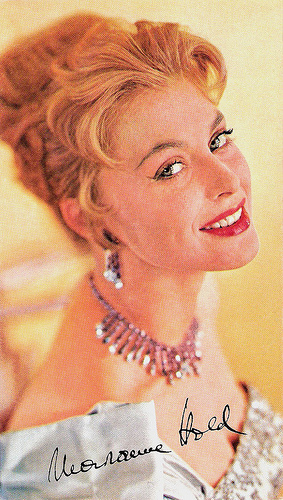
Marianne Hold . German collectors card by Lux.
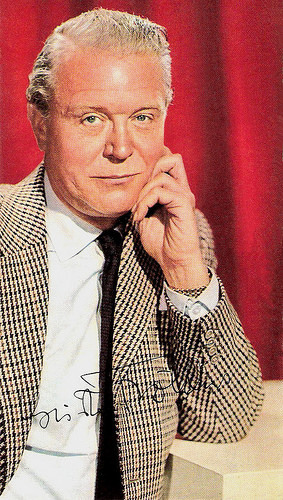
Gustav Fröhlich . German collectors card by Lux.
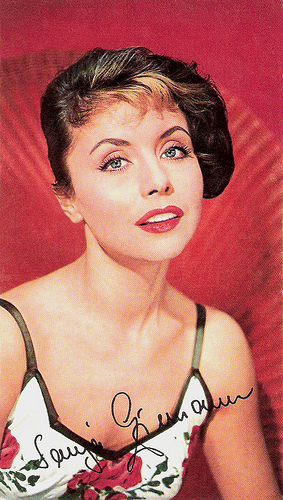
Sonja Ziemann . German collectors card by Lux.
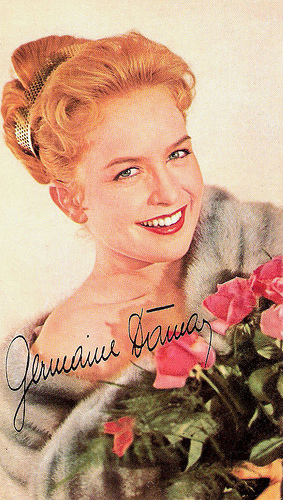
Germaine Damar . German collectors card by Lux.
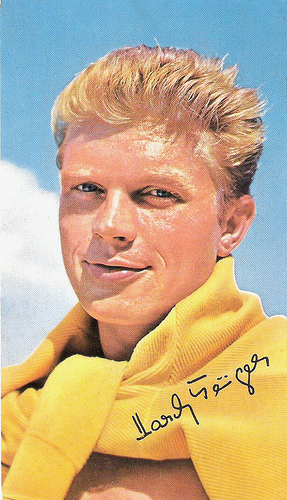
Hardy Krüger . German collectors card by Lux.
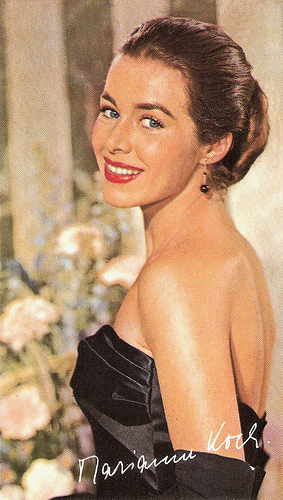
Marianne Koch . German collectors card by Lux.
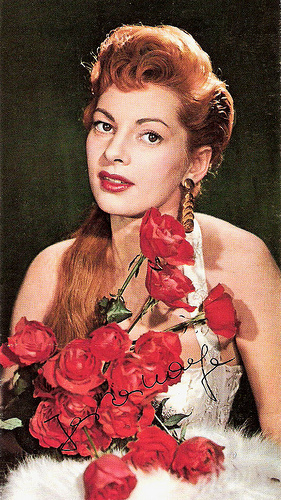
Jester Naefe . German collectors card by Lux.
Source: Wikipedia.
It is Postcard Friendship Friday, hosted by Beth at the The Best Hearts are Crunchy. You can visit her by clicking on the button below.


Lilli Palmer . German collectors card by Lux.

Johannes Heesters . German collectors card by Lux.

Nadja Tiller . German collectors card by Lux.

O.W. Fischer . German collectors card by Lux.

Nadja Tiller . German collectors card by Lux.

Liselotte Pulver . German collectors card by Lux.

Heinz Rühmann . German collectors card by Lux.

Marianne Hold . German collectors card by Lux.

Gustav Fröhlich . German collectors card by Lux.

Sonja Ziemann . German collectors card by Lux.

Germaine Damar . German collectors card by Lux.

Hardy Krüger . German collectors card by Lux.

Marianne Koch . German collectors card by Lux.

Jester Naefe . German collectors card by Lux.
Source: Wikipedia.
It is Postcard Friendship Friday, hosted by Beth at the The Best Hearts are Crunchy. You can visit her by clicking on the button below.

Published on January 25, 2018 22:00
Paul van Yperen's Blog
- Paul van Yperen's profile
- 13 followers
Paul van Yperen isn't a Goodreads Author
(yet),
but they
do have a blog,
so here are some recent posts imported from
their feed.



